Voxx Electronics DEI487 2 Way LED User Manual N567V 05 04
DEI Headquarters, Inc. 2 Way LED N567V 05 04
Contents
- 1. installation
- 2. user
installation

© 2004 Directed Electronics, Inc. Vista, CA
N567V 05-04
NOTE: This product is intended for installation by a professional installer only!
Any attempt to install this product by any person other than a trained professional
may result in severe damage to a vehicle’s electrical system and components.
MMooddeell 777711 XXVV
IInnssttaallllaattiioonn GGuuiiddee
®

22© 2004 Directed Electronics, Inc. Vista, CA
Bitwriter™, Code Hopping™, Doubleguard®, ESP™, FailSafe®, Ghost Switch™, Learn Routine™,
Nite-Lite®, Nuisance Prevention Circuitry®, NPC®, Revenger®, Silent Mode™, Soft Chirp®,
Stinger®, Valet®, Vehicle Recovery System®, VRS®, and Warn Away® are all Trademarks or
Registered Trademarks of Directed Electronics, Inc.
NNeeww SSooffttwwaarree CCoommppaattiibbiilliittyy ffoorr 110033TT
KKeeyyppaadd
This unit now has software that
allows arming with entry delay when
used in conjunction with the optional
110033TTKeypad. Refer to the 103T
Owner’s Guide for details.
The Bitwriter®(p/n 998T)
requires chip version 1.4 or
newer to program this unit.

© 2004 Directed Electronics, Inc. Vista, CA 33
ttaabbllee ooff ccoonntteennttss
wwhhaatt iiss iinncclluuddeedd.. .. .. .. .. .. .. .. .. .. .. .. .. .. .. .. .. .. .. .. .. .. .. .. .. .. .. .. 44
wwaarrnniinngg!! ssaaffeettyy ffiirrsstt.. .. .. .. .. .. .. .. .. .. .. .. .. .. .. .. .. .. .. .. .. .. .. .. .. 44
iinnssttaallllaattiioonn ppooiinnttss ttoo rreemmeemmbbeerr.. .. .. .. .. .. .. .. .. .. .. .. .. .. .. .. .. 55
before beginning the installation . . . . . . . . . . . . . 5
after the installation. . . . . . . . . . . . . . . . . . . . . . 5
ddeecciiddiinngg oonn ccoommppoonneenntt llooccaattiioonnss.. .. .. .. .. .. .. .. .. .. .. .. .. .. .. .. 66
locations for the siren. . . . . . . . . . . . . . . . . . . . . 6
locations for the control module. . . . . . . . . . . . . . 6
locations for stinger doubleguard shock sensor . . . . 7
locations for valet/program switch . . . . . . . . . . . . 8
locations for the status LED . . . . . . . . . . . . . . . . . 8
locations for the optional starter kill relay . . . . . . . 9
locations for the relay satellite. . . . . . . . . . . . . . . 9
ffiinnddiinngg tthhee wwiirreess yyoouu nneeeedd.. .. .. .. .. .. .. .. .. .. .. .. .. .. .. .. .. .. .. .. 99
obtaining constant 12V . . . . . . . . . . . . . . . . . . . . 9
finding the 12V switched ignition wire. . . . . . . . . 10
finding the starter wire . . . . . . . . . . . . . . . . . . . 10
finding the accessory wire . . . . . . . . . . . . . . . . . 11
finding the tachometer wire . . . . . . . . . . . . . . . . 11
finding the wait-to-start bulb wire for diesels . . . 11
finding a (+) parking light wire. . . . . . . . . . . . . . 12
finding the door pin switch circuit . . . . . . . . . . . 12
mmaakkiinngg yyoouurr wwiirriinngg ccoonnnneeccttiioonnss.. .. .. .. .. .. .. .. .. .. .. .. .. .. .. .. 1133
pprriimmaarryy hhaarrnneessss ((HH11)),, 1122--ppiinn ccoonnnneeccttoorr.. .. .. .. .. .. .. .. .. .. .. 1144
sseeccoonnddaarryy hhaarrnneessss ((HH22)),, 66--ppiinn ccoonnnneeccttoorr.. .. .. .. .. .. .. .. .. .. 1144
ddoooorr lloocckk hhaarrnneessss,, 33--ppiinn ccoonnnneeccttoorr.. .. .. .. .. .. .. .. .. .. .. .. .. .. 1155
rreemmoottee ssttaarrtt pprriimmaarryy hhaarrnneessss,, 77--ppiinn ccoonnnneeccttoorr.. .. .. .. .. .. 1155
hheeaavvyy ggaauuggee iinnlliinnee ccoonnnneeccttoorr kkeeyy sswwiittcchh iinntteerrffaaccee.. .. .. 1166
rreemmoottee ssttaarrtt sseeccoonnddaarryy hhaarrnneessss ((HH33)),,55--ppiinn ccoonnnneeccttoorr.. 1166
pprriimmaarryy hhaarrnneessss ((HH11)) wwiirree ccoonnnneeccttiioonn gguuiiddee.. .. .. .. .. .. .. .. 1177
sseeccoonnddaarryy hhaarrnneessss ((HH22)) wwiirree ccoonnnneeccttiioonn gguuiiddee.. .. .. .. .. .. 2211
rreellaayy ssaatteelllliittee iiggnniittiioonn sswwiittcchh iinntteerrffaaccee wwiirree ccoonnnneeccttiioonn
gguuiiddee.. .. .. .. .. .. .. .. .. .. .. .. .. .. .. .. .. .. .. .. .. .. .. .. .. .. .. .. .. .. .. .. .. .. 2233
heavy gauge wires . . . . . . . . . . . . . . . . . . . . . . 23
ribbon harness . . . . . . . . . . . . . . . . . . . . . . . . . 24
auxiliary relay output harness. . . . . . . . . . . . . . . 24
rreemmoottee ssttaarrtt sseeccoonnddaarryy hhaarrnneessss ((HH33)) wwiirree ccoonnnneeccttiioonn gguuiiddee
.. .. .. .. .. .. .. .. .. .. .. .. .. .. .. .. .. .. .. .. .. .. .. .. .. .. .. .. .. .. .. .. .. .. .. .. .. .. 2255
nneeuuttrraall ssaaffeettyy sswwiittcchh iinntteerrffaaccee.. .. .. .. .. .. .. .. .. .. .. .. .. .. .. .. .. 2277
testing the neutral safety switch. . . . . . . . . . . . . 27
bbyyppaassssiinngg GGMM vveehhiiccllee aannttii--tthheefftt ssyysstteemmss ((VVAATTSS)).. .. .. .. .. 3300
11999955 aanndd nneewweerr vveehhiiccllee aannttii--tthheefftt ssyysstteemmss .. .. .. .. .. .. .. .. ..
((iimmmmoobbiilliizzeerrss)).. .. .. .. .. .. .. .. .. .. .. .. .. .. .. .. .. .. .. .. .. .. .. .. .. .. .. .. 3311
passlock I and passlock II (PL-1 and PL-2). . . . . . 31
passkey III (PK-3), transponder-based systems . . . 31
pplluugg--iinn LLEEDD aanndd vvaalleett//pprrooggrraamm sswwiittcchh.. .. .. .. .. .. .. .. .. .. .. .. 3322
pprrooggrraammmmeerr iinntteerrffaaccee,, 33--ppiinn bbllaacckk pplluugg.. .. .. .. .. .. .. .. .. .. .. 3322
sshhoocckk sseennssoorr hhaarrnneessss,, 44--ppiinn ccoonnnneeccttoorr.. .. .. .. .. .. .. .. .. .. .. .. 3333
ttaacchh lleeaarrnniinngg.. .. .. .. .. .. .. .. .. .. .. .. .. .. .. .. .. .. .. .. .. .. .. .. .. .. .. .. .. 3344
pprrooggrraammmmiinngg jjuummppeerrss.. .. .. .. .. .. .. .. .. .. .. .. .. .. .. .. .. .. .. .. .. .. .. 3344
tach threshold on/off . . . . . . . . . . . . . . . . . . . . 35
light flash (+)/(-) . . . . . . . . . . . . . . . . . . . . . . . 35
ttrraannssmmiitttteerr//rreecceeiivveerr lleeaarrnn rroouuttiinnee™™.. .. .. .. .. .. .. .. .. .. .. .. .. .. 3355
ttrraannssmmiitttteerr ccoonnffiigguurraattiioonnss.. .. .. .. .. .. .. .. .. .. .. .. .. .. .. .. .. .. .. .. 3377
standard configuration. . . . . . . . . . . . . . . . . . . . 37
ssyysstteemm ffeeaattuurreess lleeaarrnn rroouuttiinnee.. .. .. .. .. .. .. .. .. .. .. .. .. .. .. .. .. .. 3388
ffeeaattuurree mmeennuuss.. .. .. .. .. .. .. .. .. .. .. .. .. .. .. .. .. .. .. .. .. .. .. .. .. .. .. .. 4400
menu #1 - basic features . . . . . . . . . . . . . . . . . . 40
menu #2 - advanced features . . . . . . . . . . . . . . . 41
menu #3 - remote start options . . . . . . . . . . . . . 41
ffeeaattuurree ddeessccrriippttiioonnss.. .. .. .. .. .. .. .. .. .. .. .. .. .. .. .. .. .. .. .. .. .. .. .. 4422
menu #1 - basic features . . . . . . . . . . . . . . . . . . 42
menu #2 - advanced features . . . . . . . . . . . . . . . 43
menu #3 - remote start options . . . . . . . . . . . . . 45
nnuuiissaannccee pprreevveennttiioonn cciirrccuuiittrryy™™.. .. .. .. .. .. .. .. .. .. .. .. .. .. .. .. .. 4466
vvaalleett mmooddee.. .. .. .. .. .. .. .. .. .. .. .. .. .. .. .. .. .. .. .. .. .. .. .. .. .. .. .. .. .. .. 4477
ttiimmeerr mmooddee.. .. .. .. .. .. .. .. .. .. .. .. .. .. .. .. .. .. .. .. .. .. .. .. .. .. .. .. .. .. 4477
ttaabbllee ooff zzoonneess.. .. .. .. .. .. .. .. .. .. .. .. .. .. .. .. .. .. .. .. .. .. .. .. .. .. .. .. 4488
sshhuuttddoowwnn ddiiaaggnnoossttiiccss.. .. .. .. .. .. .. .. .. .. .. .. .. .. .. .. .. .. .. .. .. .. .. 4488
to perform shutdown diagnostics . . . . . . . . . . . . 48
lloonngg tteerrmm eevveenntt hhiissttoorryy.. .. .. .. .. .. .. .. .. .. .. .. .. .. .. .. .. .. .. .. .. .. 4499
ssaaffeettyy cchheecckk.. .. .. .. .. .. .. .. .. .. .. .. .. .. .. .. .. .. .. .. .. .. .. .. .. .. .. .. .. .. 5500
ttrroouubblleesshhoooottiinngg.. .. .. .. .. .. .. .. .. .. .. .. .. .. .. .. .. .. .. .. .. .. .. .. .. .. .. 5511
alarm troubleshooting . . . . . . . . . . . . . . . . . . . . 51
remote start troubleshooting . . . . . . . . . . . . . . . 51
wwiirriinngg qquuiicckk rreeffeerreennccee gguuiiddee.. .. .. .. .. .. .. .. .. .. .. .. .. .. .. .. .. .. 5533
rreellaayy ssaatteelllliittee wwiirriinngg qquuiicckk rreeffeerreennccee gguuiiddee.. .. .. .. .. .. .. .. .. 5544

44© 2004 Directed Electronics, Inc. Vista, CA
wwhhaatt iiss iinncclluuddeedd
■The control module ■The plug-in status LED
■An XHF Plus receiver/antenna ■The plug-in Valet/Program switch
■One remote transceiver ■A hood pinswitch
■A Stinger Doubleguard shock sensor ■A toggle (override) switch
■A 514N Neosiren
wwaarrnniinngg!! ssaaffeettyy ffiirrsstt
The following safety warnings must be observed at all times:
■Due to the complexity of this system, installation of this product must only be performed by an authorized
Directed Electronics dealer.
■When properly installed, this system can start the vehicle via a command signal from the remote control
transmitter. Therefore, never operate the system in an area that does not have adequate ventilation. The fol-
lowing precautions are the sole responsibility of the user; however, authorized Directed Electronics dealers
should make the following recommendations to all users of this system:
1. Never operate the system in an enclosed or partially enclosed area without ventilation (such as a garage).
2. When parking in an enclosed or partially enclosed area or when having the vehicle serviced, the remote
start system must be disabled using the installed toggle switch.
3. It is the user's sole responsibility to properly handle and keep out of reach from children all remote
control transmitters to assure that the system does not unintentionally remote start the vehicle.
4. TTHHEE UUSSEERR MMUUSSTT IINNSSTTAALLLL AA CCAARRBBOONN MMOONNOOXXIIDDEE DDEETTEECCTTOORR IINN OORR AABBOOUUTT TTHHEE LLIIVVIINNGG AARREEAA AADDJJAACCEENNTT TTOO
TTHHEE VVEEHHIICCLLEE.. AALLLL DDOOOORRSS LLEEAADDIINNGG FFRROOMM AADDJJAACCEENNTT LLIIVVIINNGG AARREEAASS TTOO TTHHEE EENNCCLLOOSSEEDD OORR PPAARRTTIIAALLLLYY
EENNCCLLOOSSEEDD VVEEHHIICCLLEE SSTTOORRAAGGEE AARREEAA MMUUSSTT AATT AALLLL TTIIMMEESS RREEMMAAIINN CCLLOOSSEEDD..
■Use of this product in a manner contrary to its intended mode of operation may result in property damage,
personal injury, or death. Except when performing the Safety Check outlined in this installation guide, (1)
Never remotely start the vehicle with the vehicle in gear, and (2) Never remotely start the vehicle with the
keys in the ignition. The user will be responsible for having the neutral safety feature of the vehicle period-
ically checked, wherein the vehicle must not remotely start while the car is in gear. This testing should be
performed by an authorized Directed Electronics dealer in accordance with the Safety Check outlined in this
product installation guide. If the vehicle starts in gear, cease remote start operation immediately and consult
with the user to fix the problem immediately.
■After the remote start module has been installed, test the remote start module in accordance with the Safety

© 2004 Directed Electronics, Inc. Vista, CA 55
Check outlined in this installation guide. If the vehicle starts when performing the Neutral Safety Shutdown
Circuit test, the remote start unit has not been properly installed. The remote start module must be removed
or properly reinstalled so that the vehicle does not start in gear. All installations must be performed by an
authorized Directed Electronics dealer. OOPPEERRAATTIIOONN OOFF TTHHEE RREEMMOOTTEE SSTTAARRTT MMOODDUULLEE IIFF TTHHEE VVEEHHIICCLLEE SSTTAARRTTSS IINN
GGEEAARR IISS CCOONNTTRRAARRYY TTOO IITTSS IINNTTEENNDDEEDD MMOODDEE OOFF OOPPEERRAATTIIOONN.. OOPPEERRAATTIINNGG TTHHEE RREEMMOOTTEE SSTTAARRTT SSYYSSTTEEMM UUNNDDEERR
TTHHEESSEE CCOONNDDIITTIIOONNSS MMAAYY RREESSUULLTT IINN PPRROOPPEERRTTYY DDAAMMAAGGEE OORR PPEERRSSOONNAALL IINNJJUURRYY.. IIMMMMEEDDIIAATTEELLYY CCEEAASSEE TTHHEE UUSSEE
OOFF TTHHEE UUNNIITT AANNDD RREEPPAAIIRR OORR DDIISSCCOONNNNEECCTT TTHHEE IINNSSTTAALLLLEEDD RREEMMOOTTEE SSTTAARRTT MMOODDUULLEE.. DDIIRREECCTTEEDD EELLEECCTTRROONNIICCSS,,
IINNCC.. WWIILLLL NNOOTT BBEE HHEELLDD RREESSPPOONNSSIIBBLLEE OORR PPAAYY FFOORR IINNSSTTAALLLLAATTIIOONN OORR RREEIINNSSTTAALLLLAATTIIOONN CCOOSSTTSS..
iinnssttaallllaattiioonn ppooiinnttss ttoo rreemmeemmbbeerr
IIMMPPOORRTTAANNTT!! This product is designed for fuel-injected, automatic transmission vehicles only.
Installing it in a standard transmission vehicle is dangerous and is contrary to its intended use.
■Please read this entire installation guide before beginning the installation. The installation of this remote
start system requires interfacing with many of the vehicle’s systems. Many new vehicles use low-voltage or
multiplexed systems that can be damaged by low resistance testing devices, such as test lights and logic
probes (computer safe test lights). Test all circuits with a high quality digital multi-meter before making con-
nections.
■Do not disconnect the battery if the vehicle has an anti-theft-coded radio. If equipped with an air bag, avoid
disconnecting the battery if possible. Many airbag systems will display a diagnostic code through their
warning lights after they lose power. Disconnecting the battery requires this code to be erased, which can
require a trip to the dealer.
■Check with the customer on status LED location.
■Remove the domelight fuse. This prevents accidentally draining the battery.
■Roll down a window to avoid being locked out of the car.
■Test all functions. The “Using Your System” section of the Owner's Guide is very helpful when testing.
■When testing, don’t forget that this system is equipped with Nuisance Prevention Circuitry™(NPC™). NPC can
bypass trigger zones, making them appear to stop working. See the
Nuisance Prevention Circuitry
section.
■Review and complete the
Safety Check
section of this guide prior to the vehicle reassembly.
aafftteerr tthhee iinnssttaallllaattiioonn
bbeeffoorree bbeeggiinnnniinngg tthhee iinnssttaallllaattiioonn
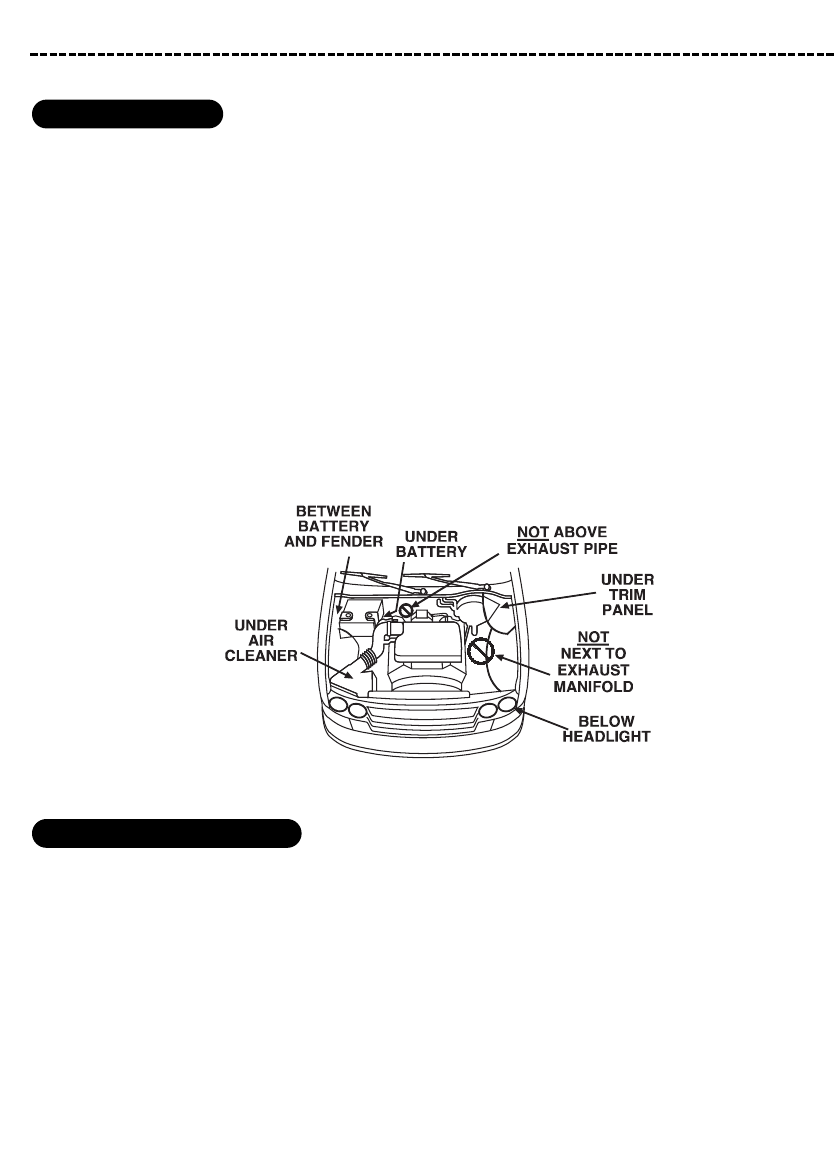
66© 2004 Directed Electronics, Inc. Vista, CA
ddeecciiddiinngg oonn ccoommppoonneenntt llooccaattiioonnss
SSoommee tthhiinnggss ttoo rreemmeemmbbeerr aabboouutt mmoouunnttiinngg tthhee ssiirreenn::
■Keep it away from heat sources, such as radiators, exhaust manifolds, turbochargers, and heat shields.
■Mount it where a thief cannot easily disconnect it, whether the hood is open or shut. Both the siren and its
wires should be difficult to find. This usually involves disguising the wire to look like a factory harness.
■We recommend against grounding the siren to its mounting screws. Instead, we recommend running both the
red and black wires into the passenger compartment and grounding to one common point for all devices.
After all, both wires are the same length and come already bonded together. Whenever possible, conceal your
wires in the factory harnesses or in the same style loom as the factory.
■When possible, place the siren on the same side of the vehicle as the control module, where its wires will
reach the control module’s wires without extending them. Always run the wires through the center of a
grommet, never through bare metal!
■Point the siren down so water does not collect in it.
SSoommee tthhiinnggss ttoo rreemmeemmbbeerr aabboouutt wwhheerree ttoo mmoouunntt tthhee ccoonnttrrooll mmoodduullee::
■Never put the control module in the engine compartment!
■The first step in hot-wiring a vehicle is removing the driver's side under-dash panel to access the starter and
ignition wires. If the control module is placed just behind the driver's side dash it can easily be disconnected.
■When mounting the control module, try to find a secure location that will not require you to extend the har-
nesses’ wires (they are 1.5 meters long). Keep it away from the heater core (or any other heat sources) and
any obvious leaks.
llooccaattiioonnss ffoorr tthhee ccoonnttrrooll mmoodduullee
llooccaattiioonnss ffoorr tthhee ssiirreenn
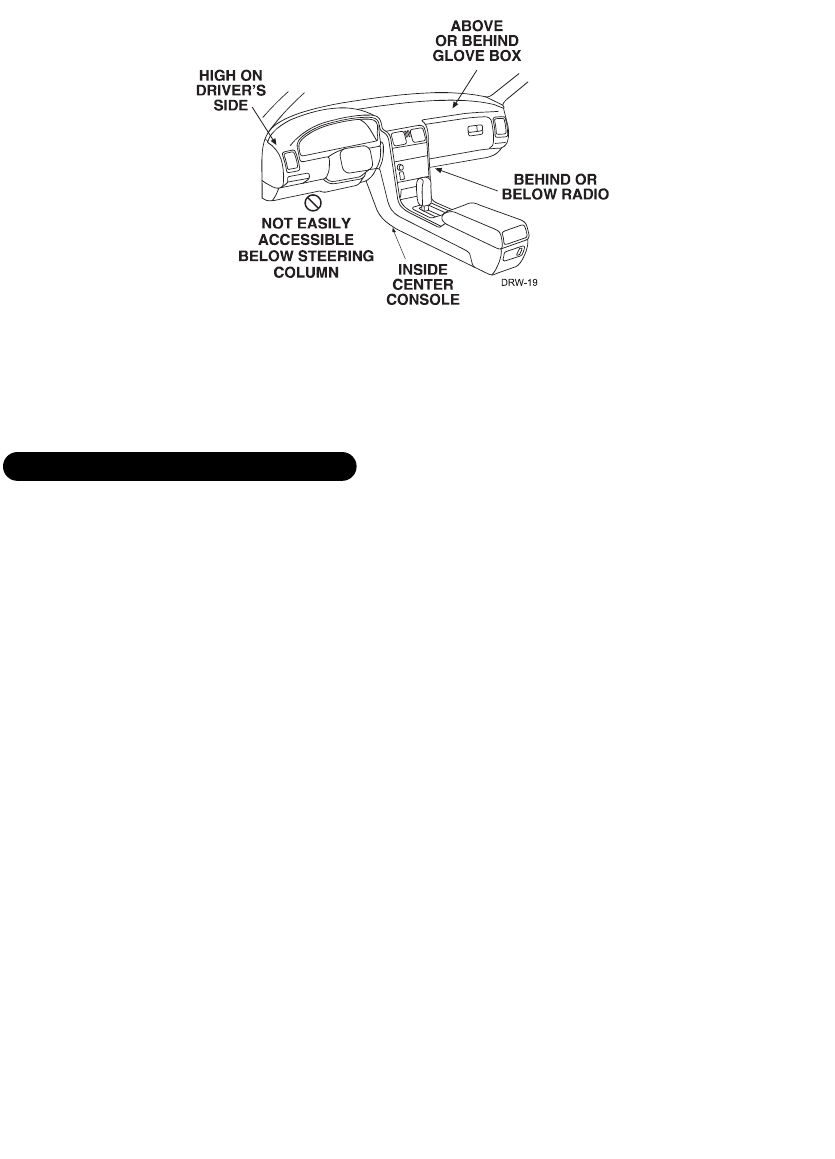
© 2004 Directed Electronics, Inc. Vista, CA 77
Some good control module locations: above the glove box, inside the center console, above the under-dash fuse
box, above the radio, etc.
SSoommee tthhiinnggss ttoo rreemmeemmbbeerr aabboouutt wwhheerree ttoo mmoouunntt tthhee sshhoocckk sseennssoorr::
■Never put the Stinger®in the engine compartment!
■Find a spot close to the control module so that the wires do not need to be extended. Keep it away from the
heater core (or any other heat sources) and any obvious leaks.
HHooww tthhee SSttiinnggeerr®®iiss mmoouunntteedd iiss tthhee mmoosstt iimmppoorrttaanntt ffaaccttoorr iinn iittss ppeerrffoorrmmaannccee.. WWee rreeccoommmmeenndd ttwwoo mmeetthhooddss::
■Using double-sided tape or hook-and-loop fastener to mount to a trim panel or an air duct, or
■Wire-tying to a wire harness.
If mounting the sensor where it cannot be easily reached for adjustment, hook-and-loop fastening tape (such as
Velcro) is recommended for ease of removal for future adjustments.
NNOOTTEE::In many vehicles, tying the sensor to a steering column or screwing it to metal will result
in poor sensitivity, especially at the rear of the vehicle.
llooccaattiioonnss ffoorr ssttiinnggeerr ddoouubblleegguuaarrdd sshhoocckk sseennssoorr
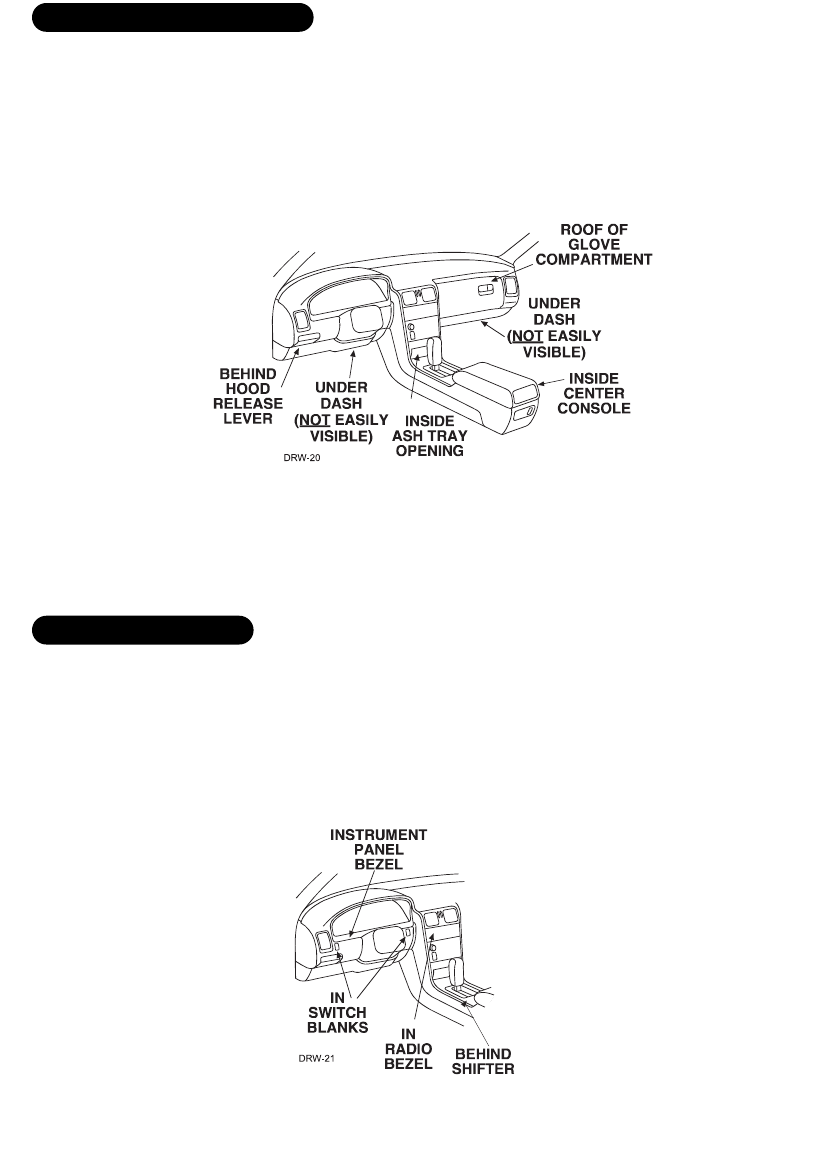
88© 2004 Directed Electronics, Inc. Vista, CA
IMPORTANT! When the vehicle is delivered, please show the user where this switch is located
and how to disarm the system with it.
Ensure that the location you pick for the switch has sufficient clearance to the rear. The switch should be well
hidden. It should be placed so passengers or stored items (such as in a glove box or center console) cannot acci-
dentally hit it. The switch fits into a 9/32-inch hole.
This system has Remote Valet. The user can enter and exit Valet® Mode without having to reach the
Valet®/Program switch. This feature was introduced so that switch location was less critical in day-to-day use. As
long as the Valet®/Program switch can be reached to disarm without a transmitter, easy access is not important.
TThhiinnggss ttoo rreemmeemmbbeerr wwhheenn ppoossiittiioonniinngg tthhee SSttaattuuss LLEEDD::
■It should be visible from both sides and the rear of the vehicle, if possible.
■It needs at least 1/2-inch clearance to the rear.
■It is easiest to remove a small panel, such as a switch blank or a dash bezel, before drilling a 9/32-inch hole.
■Use quick-disconnects near the LED wires if the panel is removable. This lets mechanics or other installers
remove the panel without cutting the wires.
llooccaattiioonnss ffoorr tthhee ssttaattuuss LLEEDD
llooccaattiioonnss ffoorr vvaalleett//pprrooggrraamm sswwiittcchh
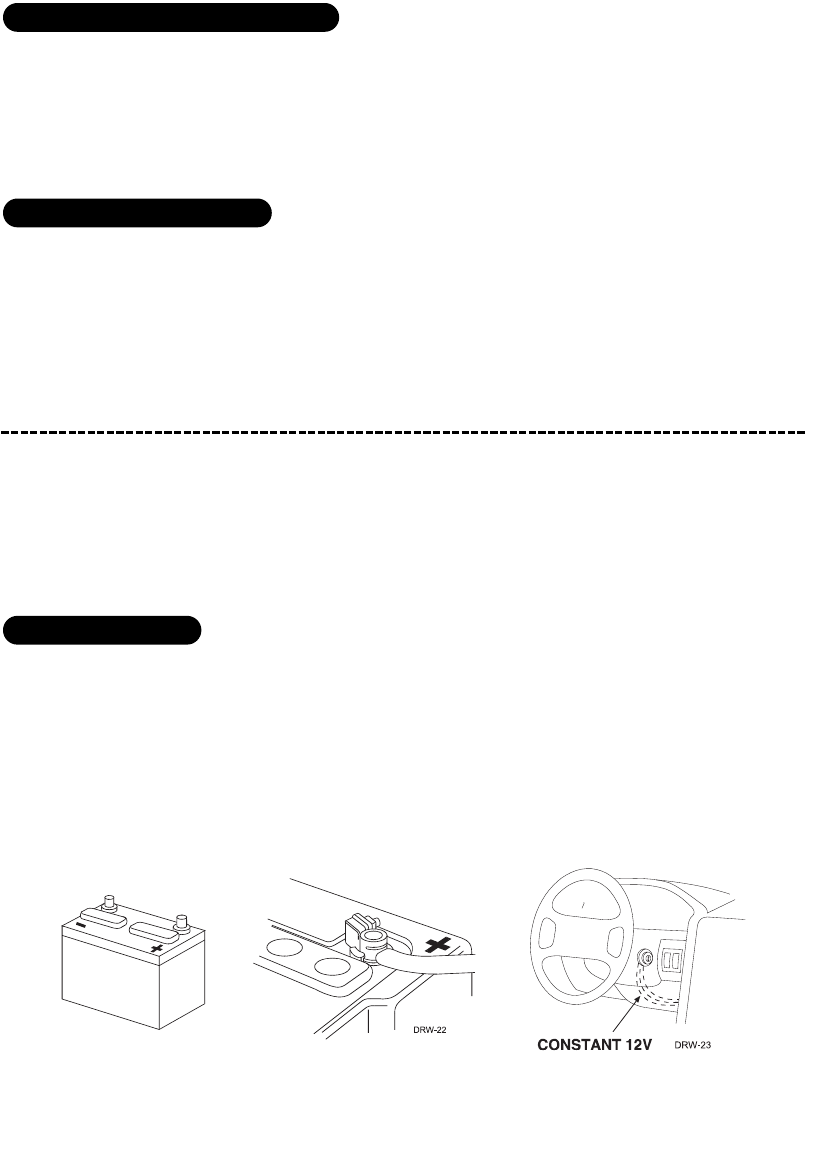
© 2004 Directed Electronics, Inc. Vista, CA 99
If optional starter kill relay or its connections are immediately visible upon removal of the under-dash panel,
they can easily be bypassed. Always make the relay and its connections difficult to discern from the factory
wiring! Exposed yellow butt connectors do not look like factory parts, and will not fool anyone! For this reason,
routing the optional starter kill wires away from the steering column is recommended.
The relay satellite wiring carries large amounts of current. The wires should not be extended and should be cut
to the minimum length necessary. Since the relay satellite is functioning as the ignition switch in the vehicle,
it is often convenient to mount the relay satellite close to the main ignition switch harness.
ffiinnddiinngg tthhee wwiirreess yyoouu nneeeedd
Now that you have decided where each component will be located, you’re going to find the wires in the car that
the security system will be connected to.
IIMMPPOORRTTAANNTT!!Do not use a 12V test light or logic probe (computer safe test light) to find these
wires! Use a digital multimeter for all testing.
We recommend two possible sources for 12V constant: the (+) terminal of the battery, or the constant supply to the
ignition switch. Always install a fuse within 12 inches of this connection. If the fuse also will be powering other
circuits, such as door locks, a power window module, a Nite-Lite® headlight control system, etc., fuse accordingly.
IIMMPPOORRTTAANNTT!! Do not remove the fuse holder on the red wire. It ensures that the control module
has its own fuse, of the proper value, regardless of how many accessories are added to the main
power feed.
oobbttaaiinniinngg ccoonnssttaanntt 1122VV
llooccaattiioonnss ffoorr tthhee rreellaayy ssaatteelllliittee
llooccaattiioonnss ffoorr tthhee ooppttiioonnaall ssttaarrtteerr kkiillll rreellaayy

1100© 2004 Directed Electronics, Inc. Vista, CA
The ignition wire is powered when the key is in the run or start position. This is because the ignition wire powers
the ignition system (spark plugs, coil) as well as the fuel delivery system (fuel pump, fuel injection computer).
Accessory wires lose power when the key is in the start position to make more current available to the starter motor.
HHooww ttoo ffiinndd ((++))1122VV iiggnniittiioonn wwiitthh yyoouurr mmuullttiimmeetteerr::
1. Set to DCV or DC voltage (12V or 20V is fine).
2. Attach the (-) probe of the meter to chassis ground.
3. Probe the wire you suspect of being the ignition wire. The
steering column harness or ignition switch harness is an excel-
lent place to find this wire.
4. Turn the ignition key switch to the run position. If your meter
reads (+)12V, go to the next step. If it doesn’t, probe another
wire.
5. Now turn the key to the start position. The meter display should stay steady, not dropping by more than a
few tenths of a volt. If it drops close to or all the way to zero, go back to Step 3. If it stays steady at (+)12V,
you have found an ignition wire.
The starter wire provides 12V directly to the starter or to a relay controlling the starter. In some vehicles, it is
necessary to power a cold start circuit. A cold start circuit will test exactly like a starter circuit, but it does not
control the starter. Instead, the cold start circuit is used to prime the fuel injection system for starting when the
vehicle is cold.
HHooww ttoo ffiinndd tthhee ssttaarrtteerr wwiirree wwiitthh yyoouurr mmuullttiimmeetteerr::
1. Set to DCV or DC voltage (12V or 20V is fine).
2. Attach the (-) probe of the meter to chassis ground.
3. Probe the wire you suspect of being the starter wire. The steering
column is an excellent place to find this wire. Remember you do not
need to interrupt the starter at the same point you test it. Hiding
your optional starter kill relay and connections is always recommended.
4. Turn the ignition key switch to the start position. Make sure the car
is not in gear! If your meter reads (+)12V, go to the next step. If it doesn’t, probe another wire.
5. Cut the wire you suspect of being the starter wire.
6. Attempt to start the car. If the starter engages, reconnect it and go back to Step 3. If the starter does not
turn over, you have the right wire.
ffiinnddiinngg tthhee ssttaarrtteerr wwiirree
ffiinnddiinngg tthhee 1122VV sswwiittcchheedd iiggnniittiioonn wwiirree

© 2004 Directed Electronics, Inc. Vista, CA 1111
An accessory wire will show +12V when the key is in the accessory and run positions. It will not show +12V during
the cranking cycle. There will often be more than one accessory wire in the ignition harness. The correct accessory
wire will power the vehicle's climate control system. Some vehicles may have separate wires for the blower motor and
the air conditioning compressor. In such cases, it will be necessary to add a relay to power the second accessory wire.
To test for a tachometer wire, a multimeter capable of testing AC voltage must be used. The tachometer wire will
show between 1V and 6V AC. In multi-coil ignition systems, the system can learn individual coil wires. Individual
coil wires in a multi-coil ignition system will register lower amounts of AC voltage. Also, if necessary, the system
can use a fuel injector control wire for engine speed sensing. Common locations for a tachometer wire are the
ignition coil itself, the back of the gauges, engine computers, and automatic transmission computers.
IIMMPPOORRTTAANNTT!!Do not test tachometer wires using a test light or logic probe (computer safe test light)!
This will damage the vehicle.
HHooww ttoo ffiinndd aa ttaacchhoommeetteerr wwiirree wwiitthh yyoouurr mmuullttiimmeetteerr::
1. Set to ACV or AC voltage (12V or 20V is fine).
2. Attach the (-) probe of the meter to chassis ground.
3. Start and run the vehicle.
4. Probe the wire you suspect of being the tachometer wire with the red probe of the meter.
5. If this is the correct wire the meter will read between 1V and 6V.
In diesel vehicles it is necessary to interface with the wire that turns on the WAIT TO START light in the dash-
board. This wire illuminates the bulb until the vehicle’s glow plugs are properly heated. When the light goes out
the vehicle can be started. This wire is always available at the connector leading to the bulb in the dashboard.
It can also be found at the Engine Control Module (ECM) in many vehicles.
TToo tteesstt aanndd ddeetteerrmmiinnee tthhee ppoollaarriittyy ooff tthhiiss wwiirree::
1. Set your multimeter to DCV or DC voltage (12 or 20V is fine).
2. Attach the (+) probe of the meter to (+)12V.
3. Probe the wire that you suspect leads to the bulb with the (-) probe of the meter.
4. Turn the ignition switch to the ON position.
5. If the meter indicates 12 volts until the light goes out you have isolated the correct wire and the wire's polar-
ity is negative (ground while the bulb is on).
6. If the meter reads zero volts until the light goes out and then reads 12 volts, you have isolated the correct
wire and the wire's polarity is positive.
ffiinnddiinngg tthhee wwaaiitt--ttoo--ssttaarrtt bbuullbb wwiirree ffoorr ddiieesseellss
ffiinnddiinngg tthhee ttaacchhoommeetteerr wwiirree
ffiinnddiinngg tthhee aacccceessssoorryy wwiirree
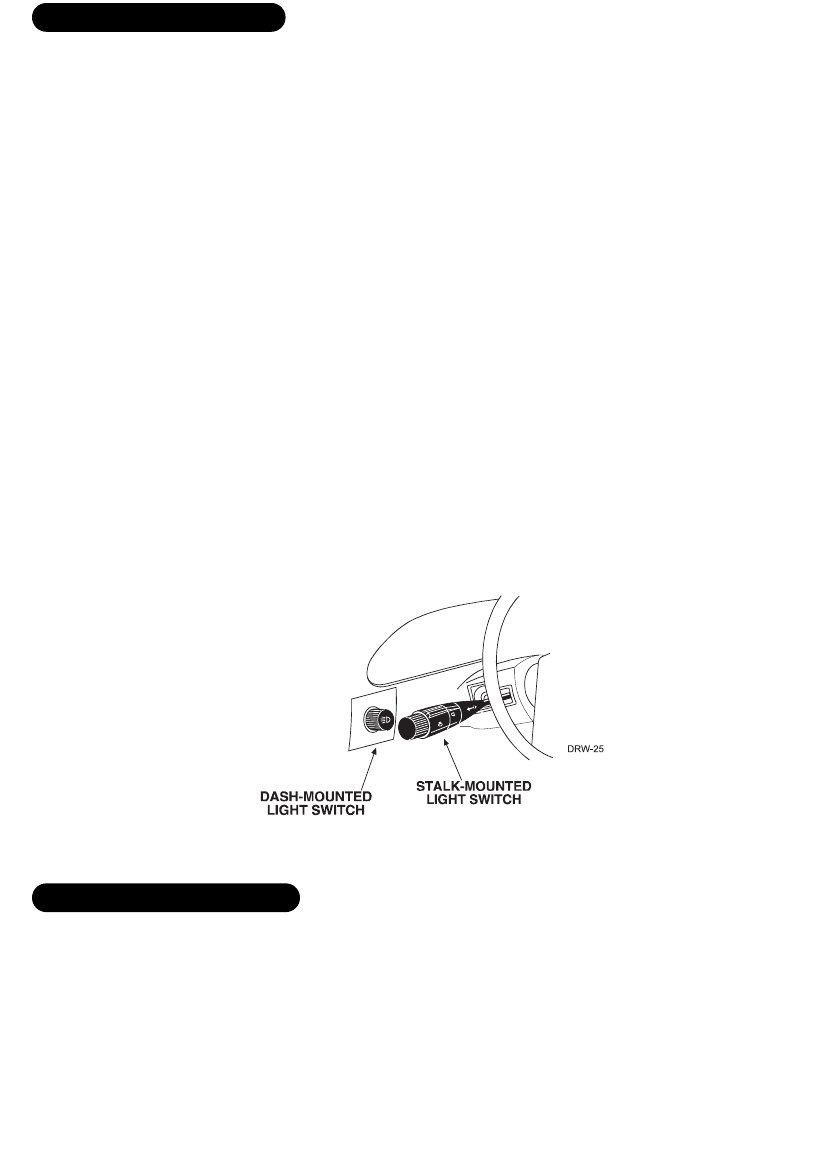
1122© 2004 Directed Electronics, Inc. Vista, CA
The (+) parking light wire is often found near the switch. Many cars have the switch built into the turn signal
lever, and in these cars the parking light wire can be found in the steering column. The same wire is often avail-
able in the kick panel or running board.
NNOOTTEE:: Many Toyotas, as well as many other Asian vehicles, send a (-) signal from the switch to
a relay. The relay then sends (+)12V to the bulbs. Whenever you have difficulty finding a (+)
parking light wire near the switch, simply test the wires at any switch or control panel which is
lit by the instrument panel lighting. Remember, you need a (+) parking light wire that does not
vary with the dimmer setting.
HHooww ttoo ffiinndd aa ((++)) ppaarrkkiinngg lliigghhtt ffllaasshh wwiirree wwiitthh yyoouurr mmuullttiimmeetteerr::
1. Set to DCV or DC voltage (12V or 20V is fine).
2. Attach the (-) probe of the meter to chassis ground.
3. Probe the wire you suspect of being the parking light wire. Usually, the area near the headlight/parking light
switch is an excellent area to start, as is the kick panel.
4. Turn on the parking lights. If your meter shows (+)12V, turn off the parking lights and make sure it goes back
to zero.
5. If it does return to zero, turn the parking lights back on and, using the dash light dimmer control, turn the
brightness of the dash lights up and down. If the meter changes more than a volt when using the dimmer,
look for another wire. If it stays relatively close to (+)12V, you have found your parking light wire.
TThhee bbeesstt ppllaacceess ttoo ffiinndd tthhee ddoooorr sswwiittcchh wwiirree aarree::
■At the pin switch: When testing at the pin switch, check the wire to ensure that it “sees” all the doors. Often,
the passenger switch will cover all the doors even if the driver’s switch will not.
■At the dome light: This may not be your best choice if the vehicle has delayed domelight supervision, but it
will work in many Hondas, or any vehicle with completely diode-isolated pin switches.
ffiinnddiinngg tthhee ddoooorr ppiinn sswwiittcchh cciirrccuuiitt
ffiinnddiinngg aa ((++)) ppaarrkkiinngg lliigghhtt wwiirree

© 2004 Directed Electronics, Inc. Vista, CA 1133
Once you have determined the wire color, the easiest place to connect to the wire is often at the kick panel, at
the windshield pillar, or in the running board. When an easy location is not available, running a wire to the dome-
light itself is often the best solution.
HHooww ttoo ffiinndd aa ddoooorr ppiinn sswwiittcchh ttrriiggggeerr wwiirree wwiitthh yyoouurr mmuullttiimmeetteerr::
1. Set to DCV or DC voltage (12V or 20V is fine).
2. In most Fords, fasten the (-) probe of the meter to chassis ground. In most other cars, fasten the (+) probe
of your meter to (+)12V constant.
3. Probe the wire you suspect of being the door trigger wire. If the meter reads (+)12V when any door
is opened, you have found a trigger wire.
NNOOTTEE::Make sure the wire you use “sees” all the doors! Some newer GM vehicles lack standard-
type pin switches. The dome light in these vehicles is turned on when the door handle is lifted.
These usually have a blue/white or white wire coming out of the door into the kick panel which
will provide a (-) trigger for all doors. Some GM vehicles (some Cavaliers, Grand Ams, etc.) have
a yellow wire coming out of the door which provides a (+) door trigger.
mmaakkiinngg yyoouurr wwiirriinngg ccoonnnneeccttiioonnss
Before making your connections, plan how your wires will be routed through the vehicle. For instance, the red
12V constant input and the orange ground-when-armed output (for the optional starter kill relay) will often be
routed together to the ignition switch harness. In order to keep the wiring neat and make it harder to find, you
may wish to wrap these wires together in electrical tape or conceal them in tubing similar to what the manu-
facturer used.
There are two acceptable ways of making a wire connection - solder connections and crimp connectors. When
properly performed, either type of connection is reliable and trouble-free. Regardless of whether you solder your
connections or you use mechanical-type crimp-on connections, ensure that all connections are mechanically
sound and that they are insulated.
Cheap electrical tape, especially when poorly applied, is not a reliable insulator. It often falls off in hot weather.
Use good-quality electrical tape or heat shrink.
■Never twist-and-tape the wires together without soldering.
■Never use “fuse taps”, as they can damage fuse box terminals.
If you use tapping connectors such as 3M T-Taps (not to be confused with Scotch-Locks), avoid using them in
higher-current applications (constant 12V, ground, etc.). Some tapping connectors are inferior in quality and
should be avoided.

1144© 2004 Directed Electronics, Inc. Vista, CA
pprriimmaarryy hhaarrnneessss ((HH11)),, 1122--ppiinn ccoonnnneeccttoorr
______
______
______
______
______
______
______
______
______
______
______
______
sseeccoonnddaarryy hhaarrnneessss ((HH22)),, 66--ppiinn ccoonnnneeccttoorr
______
______
______
______
______
______ LLIIGGHHTT BBLLUUEE((--)) SSEECCOONNDD UUNNLLOOCCKK OOUUTTPPUUTT
WWHHIITTEE//BBLLAACCKK((--)) CCHHAANNNNEELL 55 OOUUTTPPUUTT
VVIIOOLLEETT//BBLLAACCKK((--)) CCHHAANNNNEELL 44 OOUUTTPPUUTT
GGRREEEENN//WWHHIITTEE((--)) FFAACCTTOORRYY AALLAARRMM RREEAARRMM
GGRRAAYY//BBLLAACCKK((--)) WWAAIITT TTOO SSTTAARRTT
LLIIGGHHTT GGRREEEENN//BBLLAACCKK((--)) FFAACCTTOORRYY DDIISSAARRMM
HH22//11
HH22//22
HH22//33
HH22//44
HH22//55
HH22//66
RREEDD//WWHHIITTEE((--)) 220000 mmAA CCHHAANNNNEELL 22 VVAALLIIDDIITTYY OOUUTTPPUUTT
RREEDD((++)) CCOONNSSTTAANNTT PPOOWWEERR IINNPPUUTT
BBRROOWWNN((++)) SSIIRREENN OOUUTTPPUUTT
EEMMPPTTYYNNOOTT UUSSEEDD
BBLLAACCKK ((--)) CCHHAASSSSIISS GGRROOUUNNDD IINNPPUUTT
VVIIOOLLEETT ((++)) DDOOOORR TTRRIIGGGGEERR IINNPPUUTT,, ZZOONNEE 33
BBLLUUEE((--)) TTRRUUNNKK IINNPPUUTT,, ZZOONNEE 11
GGRREEEENN((--)) DDOOOORR TTRRIIGGGGEERR IINNPPUUTT,, ZZOONNEE 33
BBLLAACCKK//WWHHIITTEE((--)) 220000 mmAA DDOOMMEELLIIGGHHTT SSUUPPEERRVVIISSIIOONN OOUUTTPPUUTT
WWHHIITTEE//BBLLUUEE((--)) RREEMMOOTTEE SSTTAARRTT AACCTTIIVVAATTIIOONN IINNPPUUTT
WWHHIITTEE((++))//((--)) SSEELLEECCTTAABBLLEE LLIIGGHHTT FFLLAASSHH OOUUTTPPUUTT
OORRAANNGGEE((--)) 550000 mmAA AARRMMEEDD OOUUTTPPUUTT
HH11//11
HH11//22
HH11//33
HH11//44
HH11//55
HH11//66
HH11//77
HH11//88
HH11//99
HH11//1100
HH11//1111
HH11//1122

© 2004 Directed Electronics, Inc. Vista, CA 1155
ddoooorr lloocckk hhaarrnneessss,, 33--ppiinn ccoonnnneeccttoorr
______
______
______
rreemmoottee ssttaarrtt pprriimmaarryy hhaarrnneessss,, 77--ppiinn ccoonnnneeccttoorr
______
______
______
______
______
______
______ BBLLUUEE((--)) 220000 mmAA SSTTAATTUUSS OOUUTTPPUUTT
OORRAANNGGEE//BBLLAACCKK((--)) AANNTTIIGGRRIINNDD//GGRROOUUNNDD WWHHEENN AARRMMEEDD OOUUTTPPUUTT
PPUURRPPLLEE((--)) 220000 mmAA SSTTAARRTTEERR RREELLAAYY TTUURRNN--OONN
OORRAANNGGEE((--)) 220000 mmAA AACCCCEESSSSOORRYY RREELLAAYY TTUURRNN--OONN
PPIINNKK((--)) 220000 mmAA IIGGNNIITTIIOONN RREELLAAYY TTUURRNN--OONN
YYEELLLLOOWW((++)) IIGGNNIITTIIOONN IINNPPUUTT TTOO AALLAARRMM
PPIINNKK//WWHHIITTEE220000 mmAA ((--)) PPRROOGGRRAAMMMMAABBLLEE IIGGNN22//AACCCC22 RREELLAAYY TTUURRNN OONN
11
22
33
44
55
66
77
BBLLUUEE((++)) LLOOCCKK ((--)) UUNNLLOOCCKK OOUUTTPPUUTT
EEMMPPTTYYNNOOTT UUSSEEDD
GGRREEEENN((--)) LLOOCCKK ((++)) UUNNLLOOCCKK OOUUTTPPUUTT
11
22
33

1166© 2004 Directed Electronics, Inc. Vista, CA
hheeaavvyy ggaauuggee iinnlliinnee ccoonnnneeccttoorr
kkeeyy sswwiittcchh iinntteerrffaaccee
______
______
______
______
______
______
______
______
rreemmoottee ssttaarrtt sseeccoonnddaarryy hhaarrnneessss ((HH33)),,
55--ppiinn ccoonnnneeccttoorr
______
______
______
______
______ BBLLAACCKK//WWHHIITTEE((--)) NNEEUUTTRRAALL SSAAFFEETTYY SSWWIITTCCHH IINNPPUUTT
VVIIOOLLEETT//WWHHIITTEETTAACCHHOOMMEETTEERR IINNPPUUTT WWIIRREE
BBRROOWWNN((++)) BBRRAAKKEE SSHHUUTTDDOOWWNN WWIIRREE
GGRRAAYY((--)) HHOOOODD PPIINNSSWWIITTCCHH IINNPPUUTT,, ZZOONNEE 11
BBLLUUEE//WWHHIITTEE((--)) 220000 mmAA 22NNDD SSTTAATTUUSS//RREEAARR DDEEFFOOGGGGEERR-- LLAATTCCHHEEDD//PPUULLSSEEDD
HH33//11
HH33//22
HH33//33
HH33//44
HH33//55
RREEDD//WWHHIITTEE((++)) HHIIGGHH CCUURRRREENNTT 1122VV IINNPPUUTT
PPIINNKK//WWHHIITTEE((++)) OOUUTTPPUUTT TTOO SSEECCOONNDD IIGGNNIITTIIOONN CCIIRRCCUUIITT
RREEDD((++)) HHIIGGHH CCUURRRREENNTT 1122VV IINNPPUUTT
PPIINNKK((++)) OOUUTTPPUUTT TTOO PPRRIIMMAARRYY IIGGNNIITTIIOONN CCIIRRCCUUIITT
OORRAANNGGEE((++)) OOUUTTPPUUTT TTOO AACCCCEESSSSOORRYY CCIIRRCCUUIITT
RREEDD((++)) HHIIGGHH CCUURRRREENNTT 1122VV IINNPPUUTT
GGRREEEENNOONNBBOOAARRDD SSTTAARRTTEERR KKIILLLL ((KKEEYY SSIIDDEE))
PPUURRPPLLEE((++)) OOUUTTPPUUTT TTOO SSTTAARRTTEERR CCIIRRCCUUIITT ((SSTTAARRTTEERR SSIIDDEE))
11
22
33
44
55
66
77
88
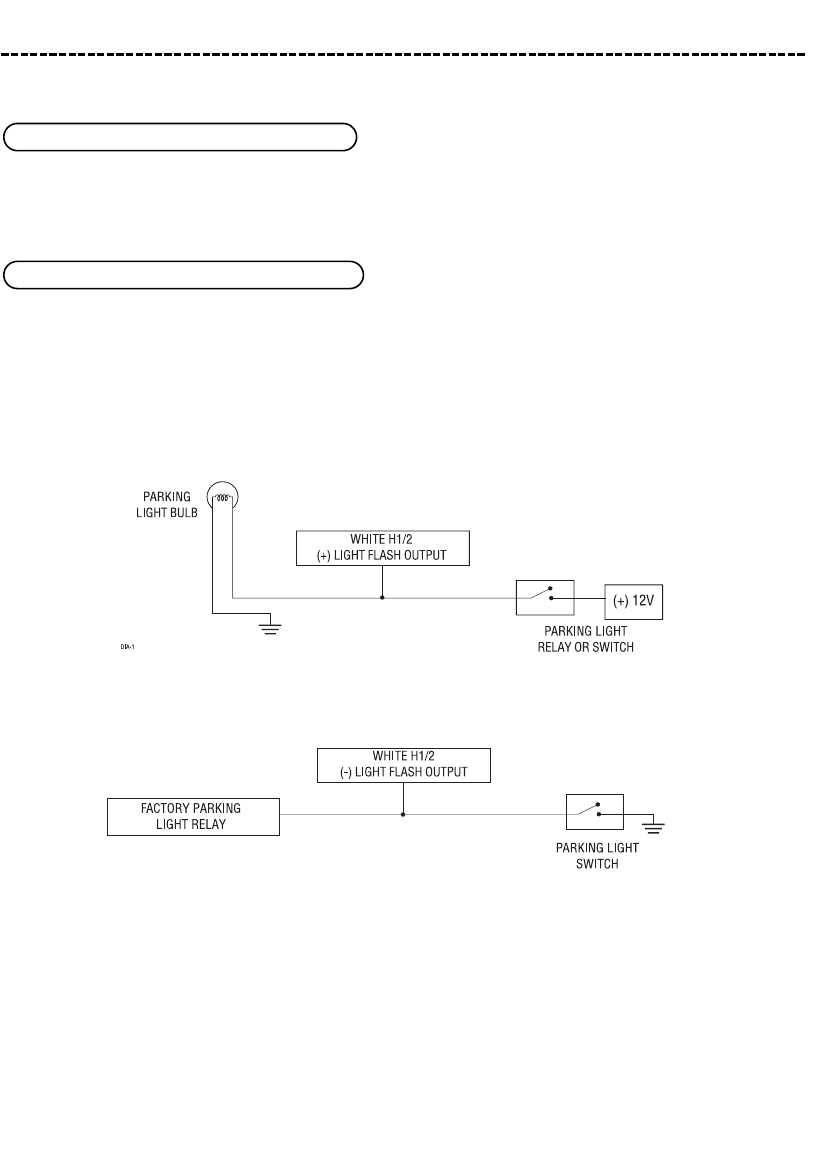
© 2004 Directed Electronics, Inc. Vista, CA 1177
pprriimmaarryy hhaarrnneessss ((HH11)) wwiirree ccoonnnneeccttiioonn gguuiiddee
This wire supplies a (-)500 mA ground as long as the system is armed. This output ceases as soon as the system
is disarmed. The orange wire may be wired to an optional Directed Electronics 8618 starter kill relay.
As shipped, this wire should be connected to the (+) parking light wire. If the light flash polarity jumper under
the sliding door is moved to the opposite position (see
Internal Programming Jumper
section of this guide), this
wire supplies a (-) 200 mA output. This is suitable for driving (-) light control wires in Toyota, Lexus, BMW, some
Mitsubishi, some Mazda, and other model cars.
((++)) PPoossiittiivvee LLiigghhtt FFllaasshh OOuuttppuutt
((--)) LLiigghhtt FFllaasshh OOuuttppuutt
NNOOTTEE::For parking light circuits that draw 10 amps or more, the internal jumper must be switched
to a (-) light flash output. (See the Internal Programming Jumper section of this guide.) PP//NN
88661177or a standard automotive SPDT relay must be used on the H1/2 light flash output harness
wire.
HH11//22 WWHHIITTEE ((++//--)) sseelleeccttaabbllee lliigghhtt ffllaasshh oouuttppuutt
HH11//11 OORRAANNGGEE ((--)) ggrroouunndd--wwhheenn--aarrmmeedd oouuttppuutt
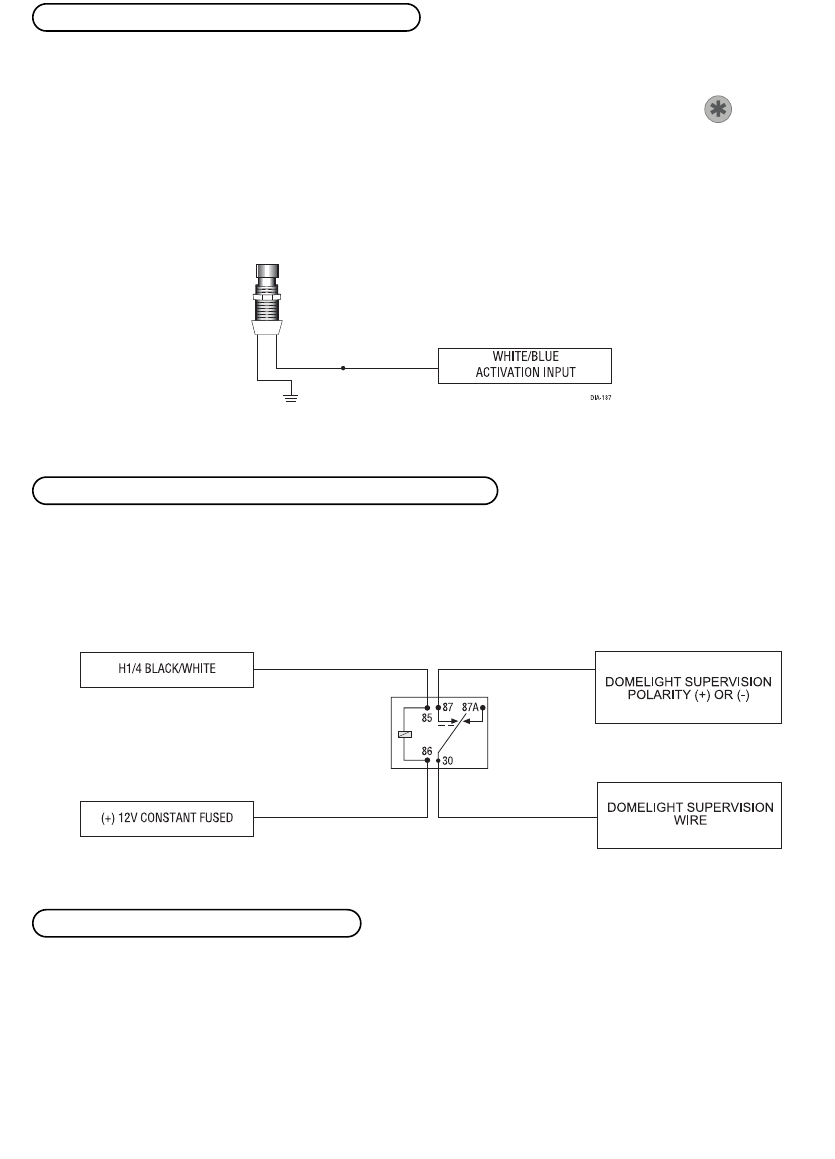
1188© 2004 Directed Electronics, Inc. Vista, CA
This input comes from the factory set to 2 activation pulses. This means that it is necessary to have 2 consecu-
tive ground pulses on the white/blue wire for the remote start to activate or to deactivate. The same holds true
for the remote control activation when set to a two pulse setting it is necessary to press the button twice
for the remote start to activate or deactivate.
NNOOTTEE::When the activation pulse count has been programmed to 1 or 2 pulses it will affect both
activation inputs; the White/Blue wire and the remote control activation.
Connect this wire to the optional domelight supervision relay as shown below:
IIMMPPOORRTTAANNTT!! This output is only intended to drive a relay. It cannot be connected directly to the
domelight circuit, as the output cannot support the current draw of one or more light bulbs.
Most vehicles use negative door trigger circuits. Connect the green wire to a wire which shows ground when any
door is opened. In vehicles with factory delays on the domelight circuit, there is usually a wire that is unaffected
by the delay circuitry. This wire will report Zone 3.
HH11//55 GGRREEEENN ((--)) ddoooorr ttrriiggggeerr iinnppuutt,, zzoonnee 33
HH11//44 BBLLAACCKK//WWHHIITTEE ((--)) 220000 mmAA ddoommeelliigghhtt ssuuppeerrvviissiioonn oouuttppuutt
HH11//33 WWHHIITTEE//BBLLUUEE rreemmoottee ssttaarrtt ((--)) aaccttiivvaattiioonn iinnppuutt
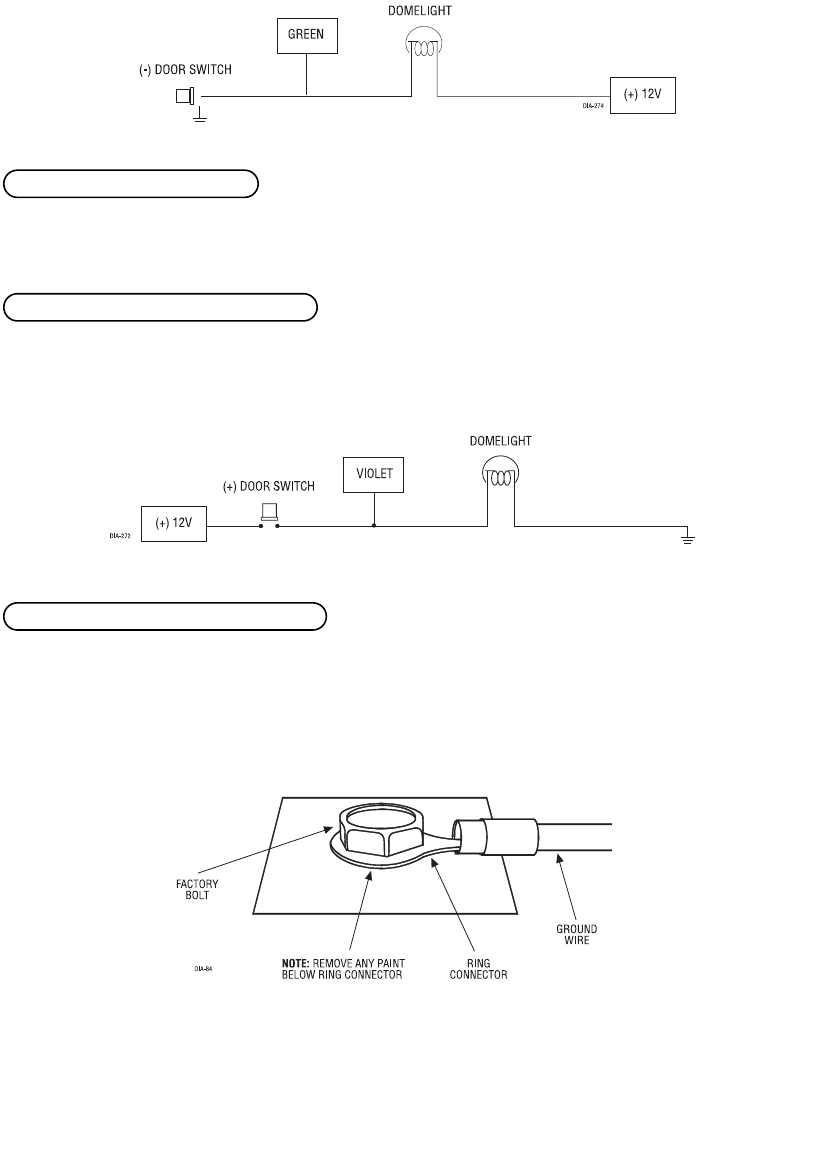
© 2004 Directed Electronics, Inc. Vista, CA 1199
This wire is connected to the trunk pinswitch. If the trunk is open while the system is armed, this input will
trigger the security system This wire will report Zone 1.
This wire is used in vehicles that have a positive (+) switched dome light circuit. Connect the violet wire to a
wire that shows (+)12V when any door is opened, and ground when the door is closed. This wire will report Zone 3.
Connect this wire to a clean, paint-free sheet metal location (driver kick panel) using a factory bolt that DOES
NOT have any vehicle component grounds attached to it. A screw should only be used when in conjunction with
a two-sided lock washer. Under dash brackets and door sheet metal are not acceptable ground points. It is rec-
ommended that all remote start/security components be grounded at the same location.
HH11//88 BBLLAACCKK ((--)) cchhaassssiiss ggrroouunndd ccoonnnneeccttiioonn
HH11//77 VVIIOOLLEETT ((++)) ddoooorr ttrriiggggeerr iinnppuutt,, zzoonnee 33
HH11//66 BBLLUUEE ((--)) ttrruunnkk iinnppuutt,, zzoonnee 11
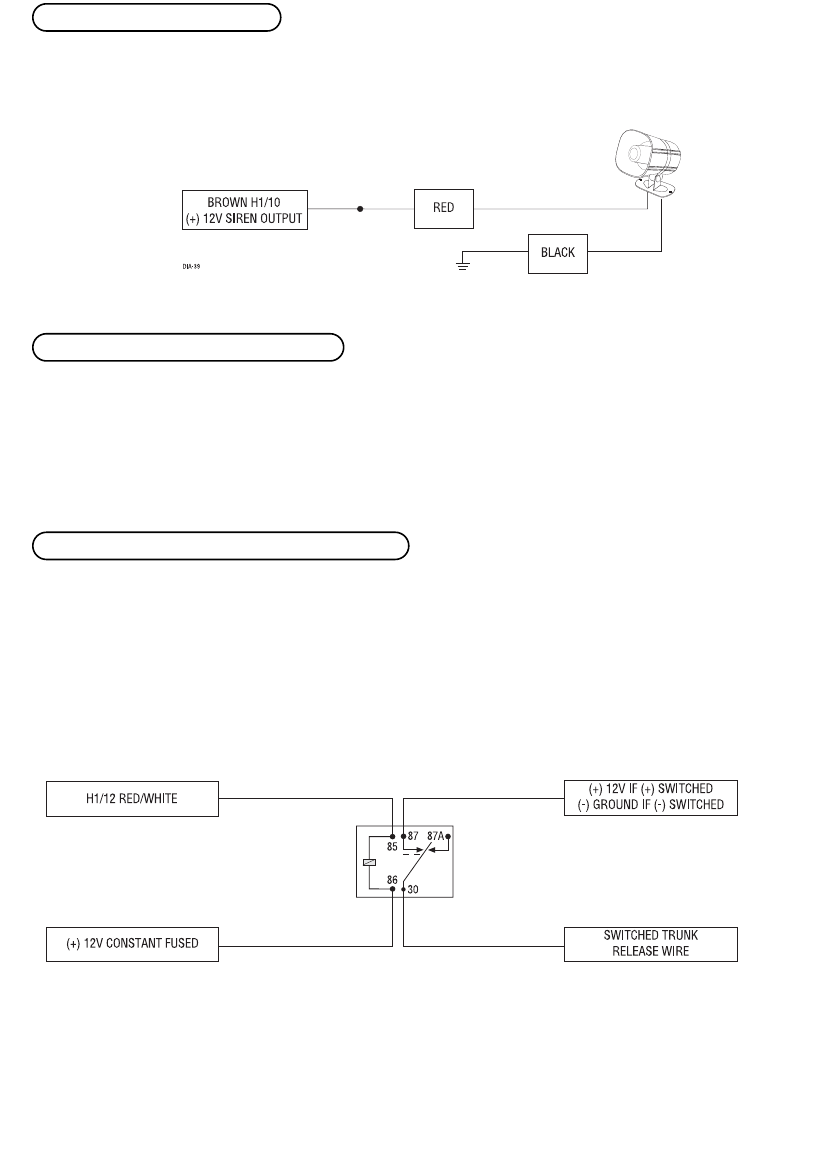
2200© 2004 Directed Electronics, Inc. Vista, CA
Connect this to the red wire of the siren. Connect the black wire of the siren to (-) chassis ground, preferably at
the same point you connected the control module’s black ground wire.
Before connecting this wire, remove the supplied fuse. Connect to the battery positive terminal or the constant
12V supply to the ignition switch.
NNOOTTEE:: Always use a fuse within 12 inches of the point you obtain (+)12V. Do not use the 15A
fuse in the harness for this purpose. This fuse protects the module itself.
When the system receives the code controlling Channel 2, for longer than 1.5 seconds, the red/white wire will
supply an output as long as the transmission continues. This is often used to operate a trunk/hatch release or
other relay-driven function.
IIMMPPOORRTTAANNTT!!Never use this wire to drive anything but a relay or a low-current input! The tran-
sistorized output can only supply 200 mA of current. Connecting directly to a solenoid, motor,
or other high-current device will cause it to fail.
HH11//1122 RREEDD//WWHHIITTEEcchhaannnneell 22,, 220000mmAA ((--)) oouuttppuutt
HH11//1111 RREEDD ((++))1122VV ccoonnssttaanntt ppoowweerr iinnppuutt
HH11//1100 BBRROOWWNN ((++)) ssiirreenn oouuttppuutt
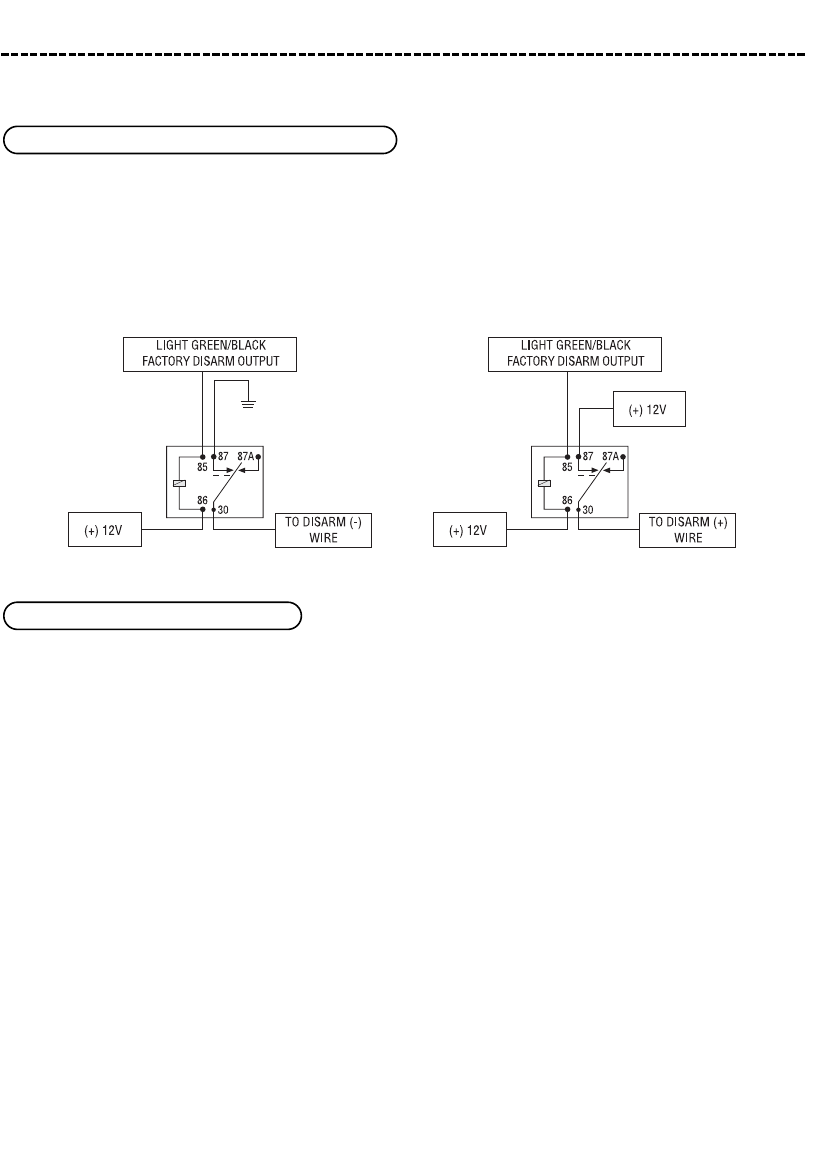
© 2004 Directed Electronics, Inc. Vista, CA 2211
sseeccoonnddaarryy hhaarrnneessss ((HH22)) wwiirree ccoonnnneeccttiioonn gguuiiddee
This wire sends a negative pulse every time the remote start is activated and the alarm is disarmed. This can be
used to pulse the disarm wire of the vehicle's factory anti-theft device. Use a relay to send a (-) or (+) pulse to
the disarm wire as shown in the diagrams below. This wire can also be used as a special accessory output. (See
Feature Descriptions
section of this guide.)
RReellaayy ffoorr NNeeggaattiivvee ((--)) DDiissaarrmm WWiirreeRReellaayy ffoorr PPoossiittiivvee ((++)) DDiissaarrmm WWiirree
Connect this wire to the wire in the vehicle that sends the signal to turn on the WAIT-TO-START bulb in the dash-
board. In most diesels the wire is negative (ground turns on the bulb) and the GRAY/BLACK wire can be directly
connected to the wire in the vehicle. If the vehicle uses a positive wire (12V to turn on the bulb) a relay must
be used to change the polarity. (See
Finding the Wires You Need
section of this guide.) Here are some common
colors of this wire:
■Chevrolet and GMC trucks - Light blue or dark blue
■Ford Trucks - Black/pink
■Dodge Ram Trucks - Orange/black or black/orange
NNOOTTEE!!A 1-amp diode must be installed in line on the factory wire between the wait-to-start
indicator and the ECM. (See the following diagram for details.)
HH22//22 GGRRAAYY//BBLLAACCKK ((--)) wwaaiitt ttoo ssttaarrtt iinnppuutt
HH22//11 LLIIGGHHTT GGRREEEENN//BBLLAACCKK ((--)) ffaaccttoorryy ddiissaarrmm oouuttppuutt
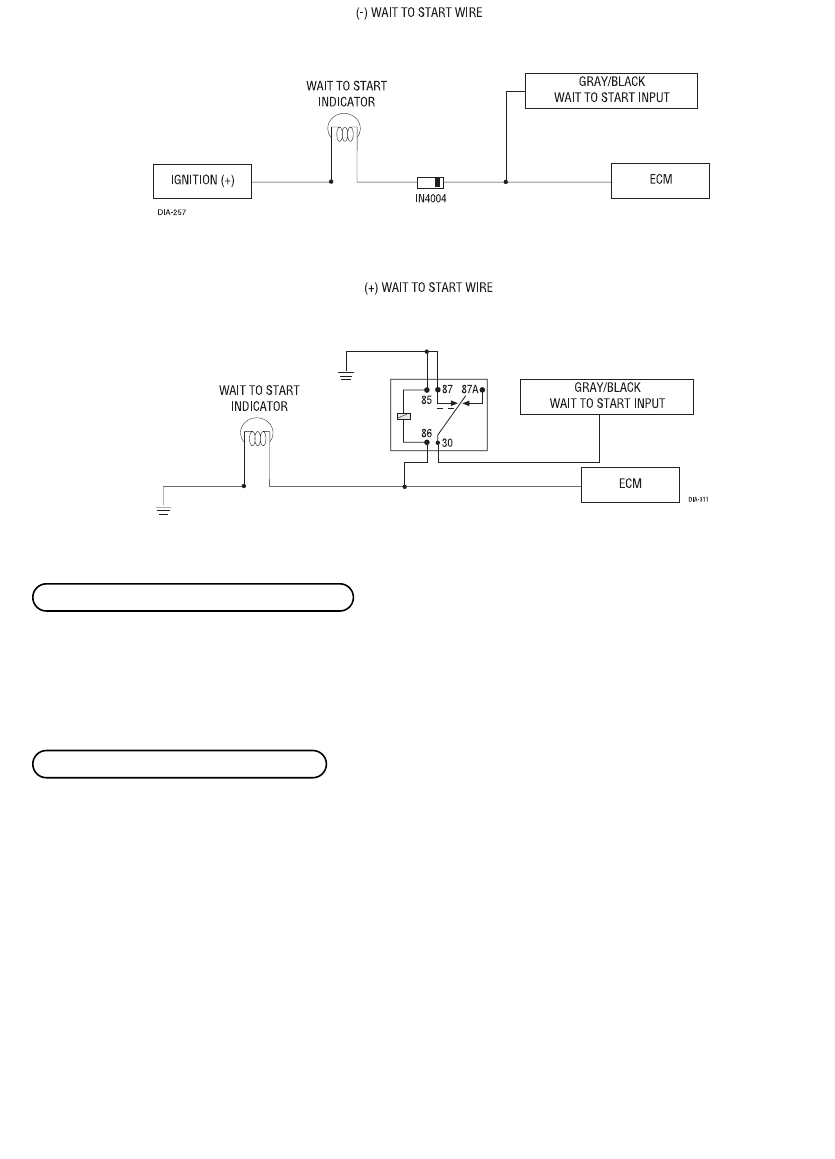
2222© 2004 Directed Electronics, Inc. Vista, CA
This wire sends a negative pulse every time the remote start shuts down or the doors are locked. This can be
used to pulse the arm wire of the vehicle's factory anti-theft device. Use a relay to send a (-) or (+) pulse to the
arm wire.
This wire provides a (-) 200mA output whenever the transmitter button(s) controlling Channel 4 is pressed. This
output can be programmed to provide the following types of outputs (see also the
Feature Menus
section):
■VVaalliiddiittyy::Output that will send a signal as long as the transmission is received.
■LLaattcchheedd:: Output that will send a signal when the Channel 4 button(s) is pressed and will continue until the
same button(s) is pressed again.
■LLaattcchheedd,, rreesseett wwiitthh iiggnniittiioonn::Similar to the latched output, this type of output turns on the first time the
Channel 4 button(s) is pressed and turns off the next time the same button is pressed. This type of output
additionally stops and resets whenever the ignition is turned on and then off.
■3300--sseeccoonndd ttiimmeedd::Output that will send a continuous signal for 30 seconds.
■SSeeccoonndd uunnlloocckk oouuttppuutt::This output can also be programmed to provide a second unlock pulse whenever the
HH22//44 VVIIOOLLEETT//BBLLAACCKK cchhaannnneell 44 oouuttppuutt
HH22//33 GGRREEEENN//WWHHIITTEE ((--)) ffaaccttoorryy aallaarrmm rreeaarrmm

© 2004 Directed Electronics, Inc. Vista, CA 2233
disarm button is pressed within 15 seconds after disarming the system. This setting could be used to unlock
the passenger doors when installing progressive door locks, for instance.
IIMMPPOORRTTAANNTT!!Never use this wire to drive anything but a relay or a low-current input! This tran-
sistorized output can only supply 200 mA, and connecting directly to a solenoid, motor, or other
high-current device will cause the module to fail.
■SSeeccoonndd uunnlloocckk oouuttppuutt::This output can also be programmed to provide a second unlock pulse whenever the
disarm button is pressed within 15 seconds after disarming the system. This setting could be used to unlock
the passenger doors when installing progressive door locks, for instance.
rreellaayy ssaatteelllliittee iiggnniittiioonn sswwiittcchh iinntteerrffaaccee
wwiirree ccoonnnneeccttiioonn gguuiiddee
The eight heavy gauge wires coming from the large connector are used to energize high current circuits in the
vehicle. It is crucial that these connections are well-made and capable of handling the current demands. For this
reason, Scotch-Locks, T-taps and other such connectors are strongly discouraged.
Connect this wire to the starter wire in the vehicle. (See
Finding the Wires You Need
section.)
For anti grind or starter kill attach this wire to the key side of the starter wire for anti grind and for the starter
kill to be active.
NNOOTTEE::If starter kill/anti-grind is not required this wire is not used.
GGRREEEENN ssttaarrtteerr iinnppuutt
PPUURRPPLLEE ((++)) ssttaarrtteerr oouuttppuutt
hheeaavvyy ggaauuggee wwiirreess
HH22//55 WWHHIITTEE//BBLLAACCKK ((--)) 22nndd uunnlloocckk oouuttppuutt

2244© 2004 Directed Electronics, Inc. Vista, CA
Remove the two 30-amp fuses prior to connecting these wires and do not replace them until the satellite has
been plugged into the control module. These wires are the source of current for all the circuits the relay satel-
lite will energize. They must be connected to a high current source. Since the factory supplies (+)12V to the key
switch that is used to operate the motor, it is recommended that these wires be connected there.
NNOOTTEE::If the factory supplies two separate (+) 12V feeds to the ignition switch, connect one RED
wire of the satellite to each feed at the switch.
Connect this wire to the accessory wire in the vehicle which powers the climate control system.
Connect this wire to the ignition wire in the vehicle.
Connection for high current outputs.
Connect this wire to the second ignition wire in the vehicle. (See
Finding the Wires You Need
section.)
NNOOTTEE:: For vehicles that do not have a second ignition wire, this connection is not required.
The ribbon harness connects from the control module.
The 4-pin harness provides the capability of driving additional relays for the following:
This wire supplies a 200mA output as soon as the control module begins the remote start process. This wire can
be used to activate an immobilizer bypass unit.
This wire supplies a 200mA output. Used when the vehicle has more than one accessory wire.
OORRAANNGGEE ((--)) 220000mmAA aacccceessssoorryy oouuttppuutt
BBLLUUEE ((--)) 220000mmAA ssttaattuuss oouuttppuutt
aauuxxiilliiaarryy rreellaayy oouuttppuutt hhaarrnneessss
rriibbbboonn hhaarrnneessss
PPIINNKK//WWHHIITTEE ((++)) sseeccoonndd iiggnniittiioonn oouuttppuutt
RREEDD//WWHHIITTEE ((++)) 1122VV iinnppuutt
PPIINNKK ((++)) iiggnniittiioonn oouuttppuutt
OORRAANNGGEE ((++)) aacccceessssoorryy oouuttppuutt
RREEDD ((qqttyy 22)) ((++))1122VV iinnppuutt ffoorr hhiigghh ccuurrrreenntt oouuttppuuttss
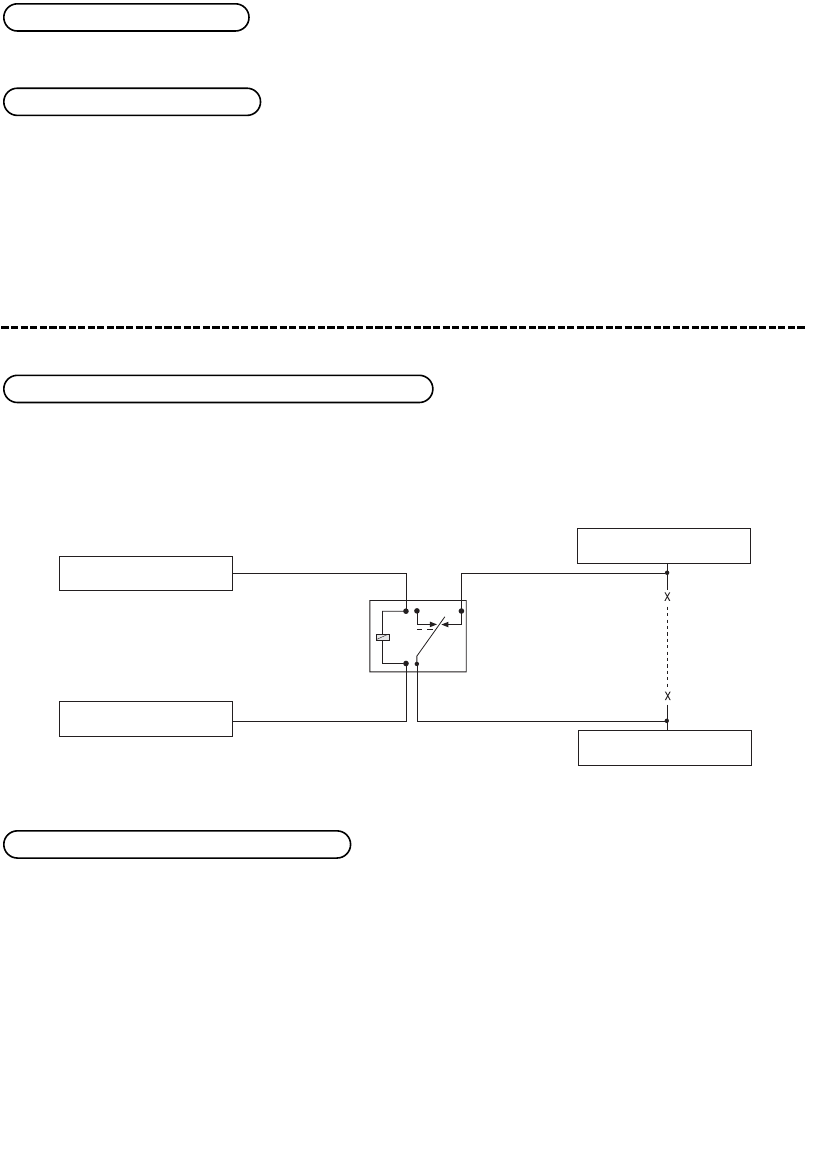
© 2004 Directed Electronics, Inc. Vista, CA 2255
This wire supplies a 200mA output during engine cranking for additional starter wire(s).
This wire supplies a 200mA output when remote start ignition is active.
rreemmoottee ssttaarrtt sseeccoonnddaarryy hhaarrnneessss ((HH33)) wwiirree ccoonn--
nneeccttiioonn gguuiiddee
This wire supplies a 200mA output as soon as the module begins the remote start process. It can be used with
a relay to disconnect a sensor from the system as shown below. This wire can also be used as a rear defogger
trigger. This output can be programmed as a pulsed output.
This wire MUST be connected to hood pinswitch. This input will disable or shut down the remote start when the hood
is opened. It will also trigger the security system if the hood is opened while the system is armed and report Zone 6.
HH33//22 GGRRAAYY ((--)) hhoooodd ppiinnsswwiittcchh iinnppuutt,, zzoonnee 66
SENSOR TRIGGER OUTPUT
SENSOR INPUT OF SYSTEM
(+) 12V FUSED
CUT
85
86 30
87 87A
DIA-141
H3/1 BLUE STATUS
OUTPUT
HH33//11 BBLLUUEE//WWHHIITTEE ((--)) ssttaattuuss//ddeeffooggggeerr oouuttppuutt
PPIINNKK ((--)) 220000mmAA 33rrddiiggnniittiioonn oouuttppuutt
PPUURRPPLLEE ((--)) 220000mmAA ssttaarrtteerr oouuttppuutt
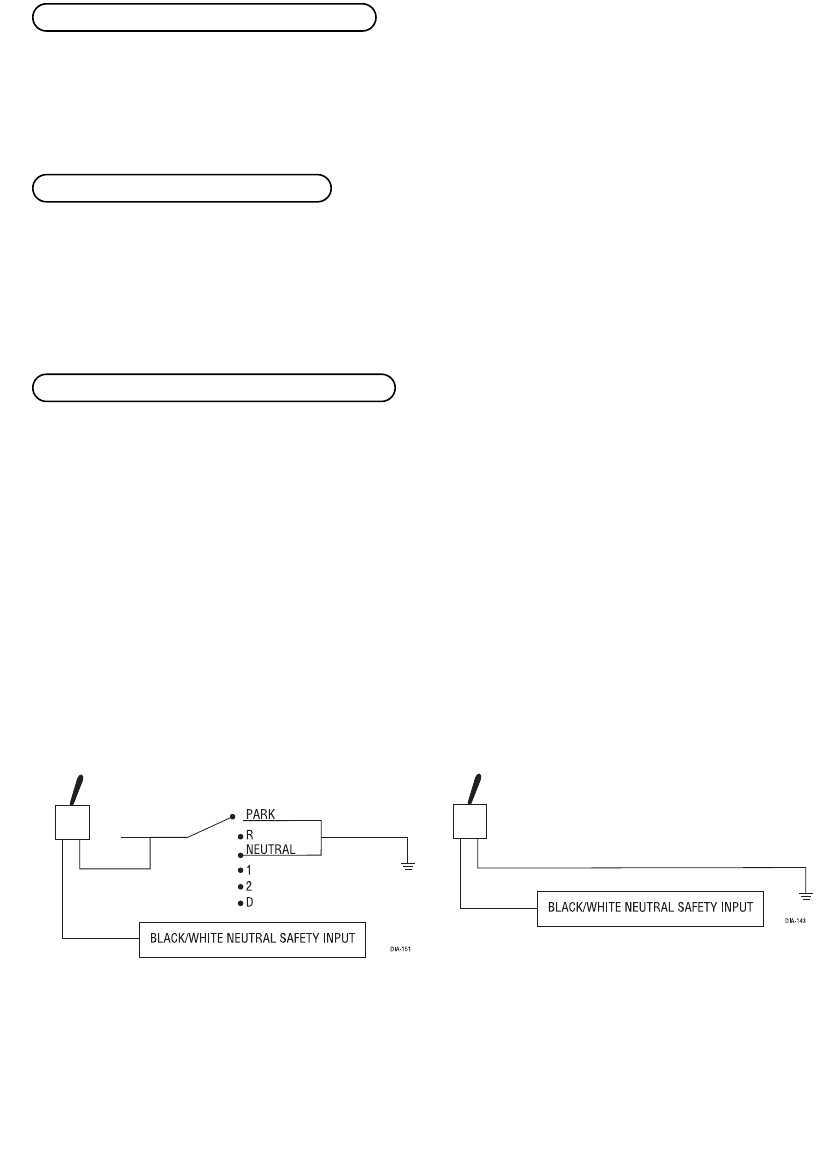
2266© 2004 Directed Electronics, Inc. Vista, CA
This wire MUST be connected to the vehicle's brake light wire. This is the wire that shows (+) 12V when the brake
pedal is depressed. The remote start will be disabled or shut down any time the brake pedal is depressed. This
wire will also trigger the security system if the brake pedal is pressed while the system is armed and will report
Zone 1.
This input provides the module with information about the engine's revolutions per minute (RPMs). It can be
connected to the negative side of the coil in vehicles with conventional coils. In multi-coil and high energy igni-
tion systems locating a proper signal may be more difficult. (See
Finding the Wires You Need
section of this
guide.) Once connected, you must teach the system the tach signal. (See the
Internal Programming Jumpers
section of this guide.)
Connect this wire to the provided toggle (override) switch as shown in figure A. Connect the other wire from the
toggle switch to the PARK/NEUTRAL switch in the vehicle. This wire will test with ground with the gear selector
either in PARK or NEUTRAL. This will prevent the vehicle from accidentally being started while in a drive gear.
This input MUST rest at ground in order for the remote start system to operate. Connected properly the vehicle
will only start while in PARK or NEUTRAL.
In some vehicles, the PARK/NEUTRAL position switch activates a factory starter lock out that will not allow the
starter to operate in a drive gear. In these vehicles, connect this wire to the toggle switch as shown in figure B.
Connect the other wire from the toggle switch to chassis ground.
IIMMPPOORRTTAANNTT!! Always perform the Safety Check section of this installation guide to verify that the
vehicle cannot be started in ANY drive gear and that the override switch is functioning properly.
FFiigguurree AAFFiigguurree BB
HH33//55 BBLLAACCKK//WWHHIITTEE nneeuuttrraall ssaaffeettyy sswwiittcchh iinnppuutt
HH33//44 VVIIOOLLEETT//WWHHIITTEE ttaacchhoommeetteerr iinnppuutt
HH33//33 BBRROOWWNN ((++)) bbrraakkee sswwiittcchh iinnppuutt,, zzoonnee 11

© 2004 Directed Electronics, Inc. Vista, CA 2277
nneeuuttrraall ssaaffeettyy sswwiittcchh iinntteerrffaaccee
Some vehicles do not have an electrical neutral safety switch. Instead, a mechanical neutral safety switch that
physically interrupts the starter wire is used when the vehicle is in any drive gear. If the remote start is inter-
faced before this switch, it will provide protection from starting in gear. However, some vehicles combine the
column shift mechanism and the mechanical neutral safety switch into one mechanical part. In these vehicles,
it is impossible to interface the remote start system before the neutral safety switch. With this type of vehicle,
if the car is left in a drive gear and the remote start system is activated, the vehicle will move and may cause
damage to persons or property.
According to available information, the only vehicles currently manufactured this way are most General Motors
trucks, sport utility vehicles and column shifting passenger cars. Available information also indicates that pre-
1996 Dodge Dakota pickups with 2.5 liter motors are manufactured this way as well.
GM vehicles that have the neutral safety switch built into the column shifter can usually be identified by a purple
starter wire. Typically, vehicles that use an outboard mechanical switch use a yellow wire from the ignition switch
to the mechanical switch and a purple wire from the mechanical switch to the starter itself. Remember, this is
only a rule of thumb and is not intended as a substitute for proper testing.
We suggest the following procedure to test for vehicles manufactured in this way.
NNOOTTEE::You must complete the remote start system installation before doing the following test.
Ensure that the remote start system is functioning normally. This includes connecting to the
brake as a shut-down.
1. Make sure there is adequate clearance to the front and rear of the vehicle because it may move slightly.
2. Make sure the hood is closed and there are no remote start shut-downs active.
3. Set the emergency brake.
4. Turn the key to the "run" position, this will release the shifter.
5. Place the car in drive (D).
6. Place your foot directly over the brake pedal, but do not depress it. Be ready to step on the brake if the
starter engages.
7. Activate the remote start system.
8. If the starter engages, immediately depress the brake to shut the remote start system down. If the starter
does not engage, no additional safety system is required.
tteessttiinngg tthhee nneeuuttrraall ssaaffeettyy sswwiittcchh

2288© 2004 Directed Electronics, Inc. Vista, CA
If the starter engages and the vehicle is a General Motors product or Dodge Dakota pickup, refer to the follow-
ing text and diagrams for an alternative shut-down method which will prevent the starter from engaging. If the
vehicle is not a General Motors product or a Dodge Dakota pickup, please call Directed Electronics Technical
Support for an alternative shut-down method. Do not return the vehicle to the customer until this feature is prop-
erly installed!
Every vehicle built in this fashion requires that the shifter be placed in park to remove the keys from the igni-
tion. As a result, it is possible to use the key-in-ignition sense switch to prevent remote starting if the keys are
in the ignition. The following diagrams illustrate how to accomplish this. The first diagram applies to all General
Motors vehicles at the present time. The second diagram applies to all pre-1996 Dodge Dakota pickup trucks with
2.5 liter motors. This solution has one side effect - if the customer inserts the key in the ignition with the driver's
door open, the remote start system will shut down. If this interface is used it is important to inform the cus-
tomer to close the driver’s door before inserting the key into the ignition when the remote start is active. This
will allow the customer to turn the key on and shut the remote start down by pressing the brake without the key
sense wire shutting down the unit prematurely.
In addition, you must connect a tan (+) shut-down input to the yellow wire on the relay satellite ribbon cable.
This prevents the remote start system from activating if the key is left in the "run" position. If your remote start
system only has one tan input, you must use diodes to isolate the ignition circuit from the brake switch input.
However, due to future manufacturer changes in vehicles, it is possible that this may not apply to all vehicles.
In addition, color variations are possible from model to model; make sure to test the circuit carefully. Please call
Directed Electronics Technical Support if you need assistance in making this interface.
IIMMPPOORRTTAANNTT!! Once the interface is complete, attempt to remote start the vehicle with the door
closed and the key in the ignition. The vehicle should not start. If it does, recheck the connections.
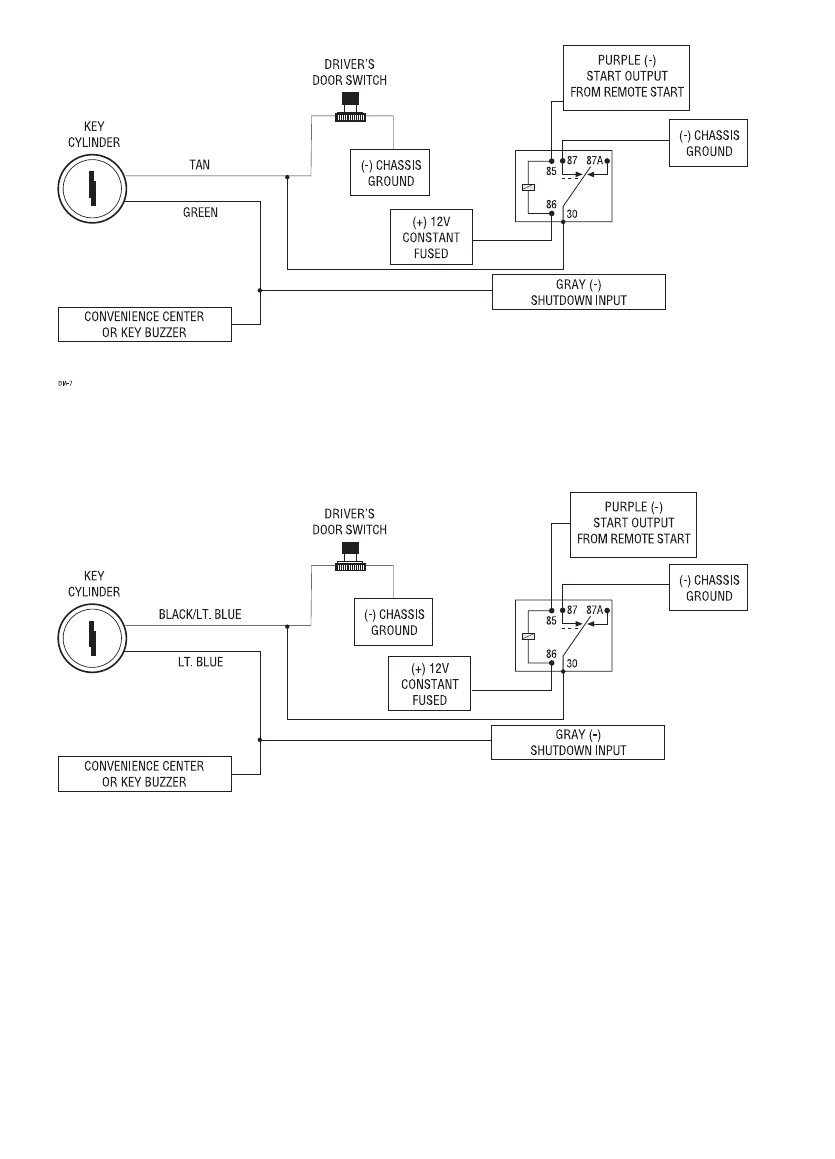
© 2004 Directed Electronics, Inc. Vista, CA 2299
GGeenneerraall MMoottoorrss ttrruucckkss,, ssppoorrtt uuttiilliittyy vveehhiicclleess aanndd ccoolluummnn sshhiiffttiinngg ppaasssseennggeerr vveehhiicclleess::
PPrree--11999966 DDooddggee DDaakkoottaa ppiicckkuuppss wwiitthh 22..55 lliitteerr mmoottoorrss::
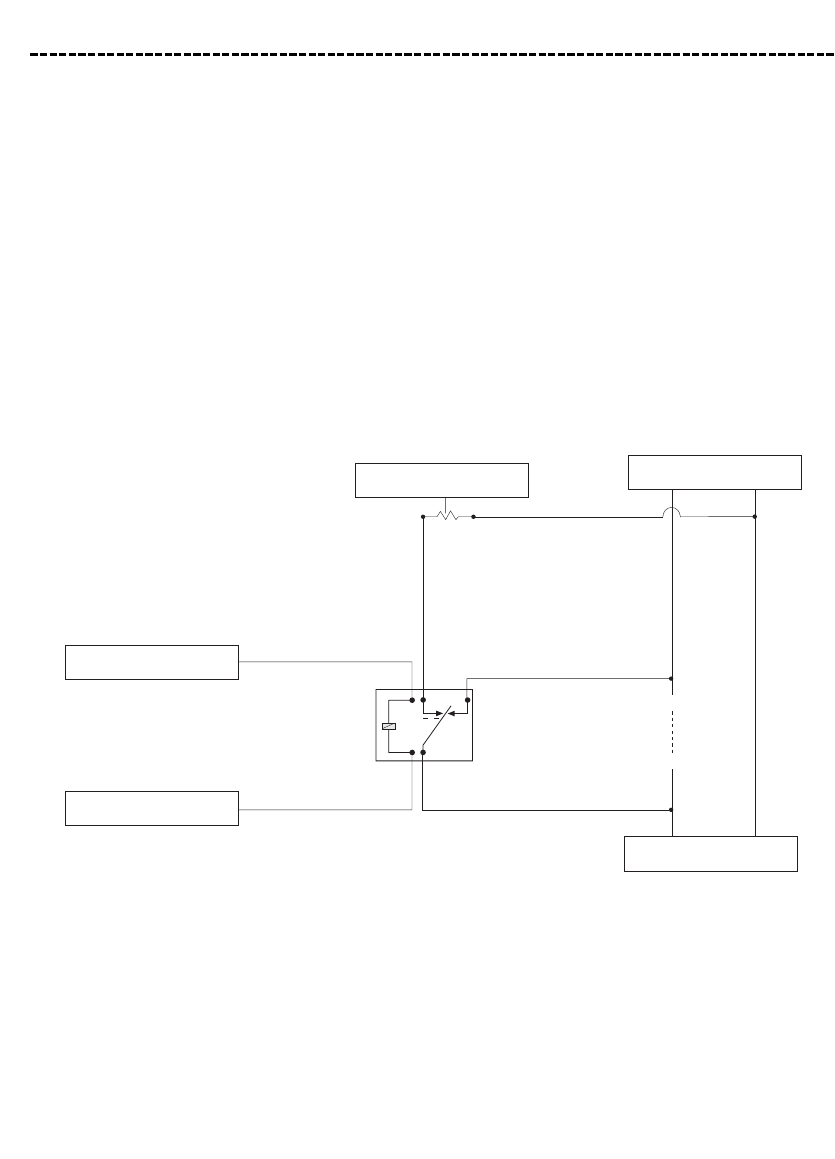
3300© 2004 Directed Electronics, Inc. Vista, CA
bbyyppaassssiinngg GGMM vveehhiiccllee aannttii--tthheefftt ssyysstteemmss ((VVAATTSS))
Vehicles with the GM VATS (Pass Key) systems have a resistor embedded in the ignition key. If the VATS decoder
module does not measure the proper resistance when the vehicle is started, the starter and fuel pump may be
disabled for up to ten minutes. An optional "VATS pack" of resistors is available ((pp//nn 665522TT)). One of the resistors in
the pack will match the resistor in the key.
The VATS wires will be two very light-gauge wires coming out of the steering column. The colors of the wires vary,
but they are often contained in orange tubing - either both will be white wires, or one wire will be purple/white
and the other white/black. Determine the value of the resistor in the key. Then follow the diagram below to
bypass VATS during remote start operation. If the H3/1 BLUE status output has been programmed for factory
security re-arm, use the H3/2 BLUE/BLACK third ignition output to control the relay.
NNOOTTEE:: When connecting to the VATS wires, it is not important which wire is cut.
H3/1 BLUE OR
H3/2 BLUE/BLACK
(+) 12V CONSTANT FUSED
85
86 30
87 87A
DIA-621
TO IGNITION KEY SWITCH
X
X
CUT
PROPER RESISTOR VALUE
TO VATS DECODER MODULE
WHITE OR WHITE/BLACK
WHITE OR PURPLE/WHITE

© 2004 Directed Electronics, Inc. Vista, CA 3311
11999955 aanndd nneewweerr vveehhiiccllee aannttii--tthheefftt ssyysstteemmss
((iimmmmoobbiilliizzeerrss))
1995 and newer vehicle anti-theft systems (immobilizers) require a bypass module. The bypass module allows for
easy interfacing, while still maintaining the OEM system’s integrity.
The Passlock I and Passlock II systems can be found in the following General Motors vehicles:
■‘95 and newer Cavalier and Sunfire
■‘96 and newer Achieva, Grand Am, and Skylark
■‘97 and newer Intrigue, Malibu, and Cutlass
■‘98 and newer trucks, vans, SUVs
■‘99 and newer Alero
■2000 and newer Impala and Saturn
Passlock I and II systems are VATS-evolved. Passlock systems still rely on the R-code to start, but the pellet is
no longer placed in the key. The resistor can now be found in the key switch. This allows for a greater number
of possible R-codes. In addition, Passlock systems require “seeing” the correct R-code at the correct time. To
bypass Passlock I and II, pp//nn 555555LLis required.
The Passkey III system can be found in the following vehicles:
■‘97 and newer Park Avenue
■‘98 and newer Cadillac
■‘99 and newer U vans, Transport, Montana, and Silhouette
■2000 and newer Grand Prix, Lesabre, Monte Carlo, Lumina, Bonneville
■2001 and newer Aurora, Aztek and Rendezvous
Other transponder-based systems include: Acura, BMW, Dodge/Chrysler/Jeep, Ford, Honda, Infinity, Mazda,
Mercedes, Mitsubishi, Nissan, Toyota, Volkswagon, and Volvo.
PK-3 and the transponder-based systems use a transponder system that locks out the ignition and fuel system.
This transponder system is comprised of two parts. The first part, the transceiver, circles the key switch and is
activated when the key is placed in the key switch or turned to the run position. Upon activation, the transceiver
ppaasssskkeeyy IIIIII ((PPKK--33)),, ttrraannssppoonnddeerr--bbaasseedd ssyysstteemmss
ppaasssslloocckk II aanndd ppaasssslloocckk IIII ((PPLL--11 aanndd PPLL--22))
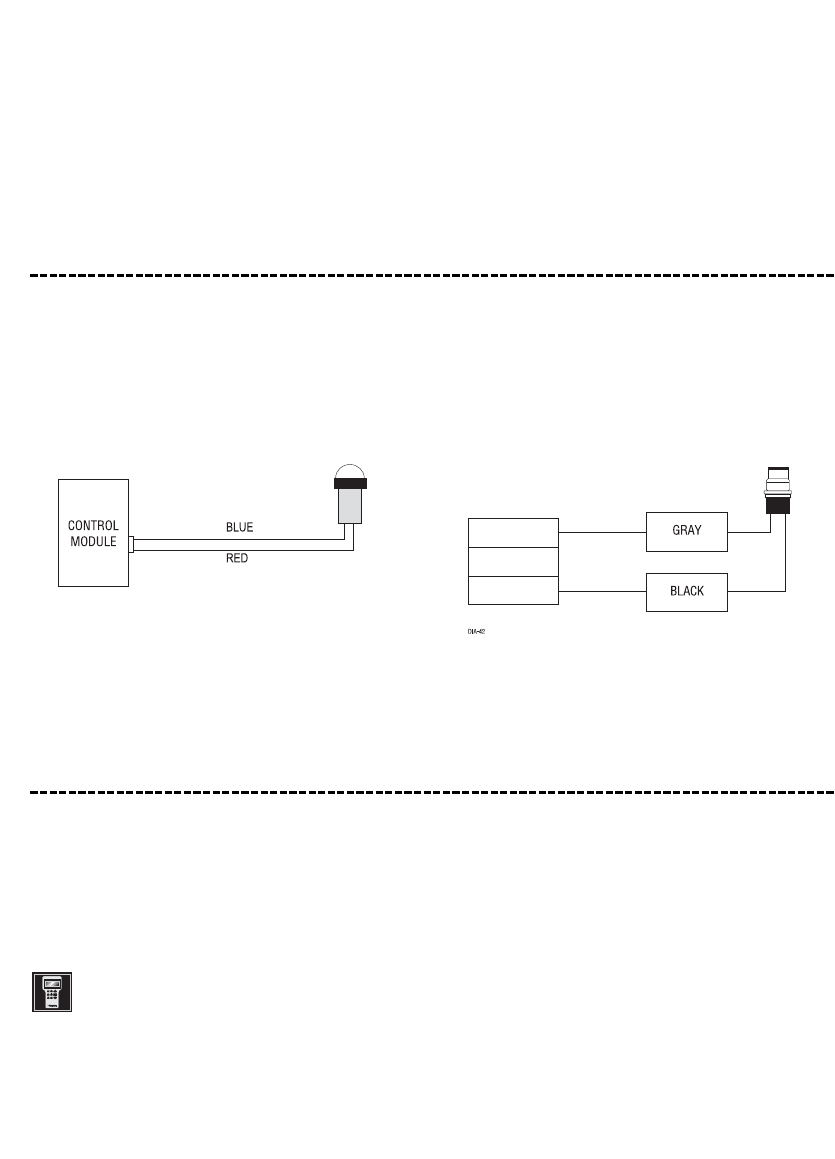
3322© 2004 Directed Electronics, Inc. Vista, CA
will excite the transponder, which is located (but not visible) in the head of the ignition key. The key transpon-
der will then send a unique code back to the transceiver for evaluation. If the code matches a valid code of the
system, the vehicle will be allowed to start. Most of these transponder-based systems can be bypassed using pp//nn
555555UU (or 555566UU). Some may require additional parts from the vehicle manufacturer. Consult you dealer for the appli-
cations. For most Ford PATS transponders, pp//nn 555555FFcan be used, except for the following vehicles, which will
require pp//nn 555555UU: ‘97 and newer Mark VII, and 2000 and newer Taurus/Sable, Contour/Mystique and Focus.
pplluugg--iinn LLEEDD aanndd vvaalleett//pprrooggrraamm sswwiittcchh
These plug into the module. The Status LED plugs into the small two-pin socket, while the Valet® /Program Switch
should be plugged into the larger blue two-pin connector. The Status LED fits into a 9/32-inch hole.
NNOOTTEE::Never use a BLUE LED in combination with a RED LED.
SSttaattuuss LLEEDDVVaalleett®®//PPrrooggrraamm SSwwiittcchh
pprrooggrraammmmeerr iinntteerrffaaccee,, 33--ppiinn bbllaacckk pplluugg
The black 3-pin port is provided for programming of the unit. The unit can also be programmed using the
Bitwriter (pp//nn 999988TT). When using the hand-held programmer, it is possible to configure any and all of the pro-
grammable functions as well as lock the Transmitter/Receiver and System Features Learn Routines so that
unauthorized users cannot change the configuration or program transmitters to the unit.
When the learn routines have previously been programmed using an optional hand-held system programmer
(pp//nn 999988TT), they may have been locked. Before proceeding with reprogramming the learn routines, they
must be unlocked with the 998T - this cannot be done manually with the Valet switch.
DIA-41
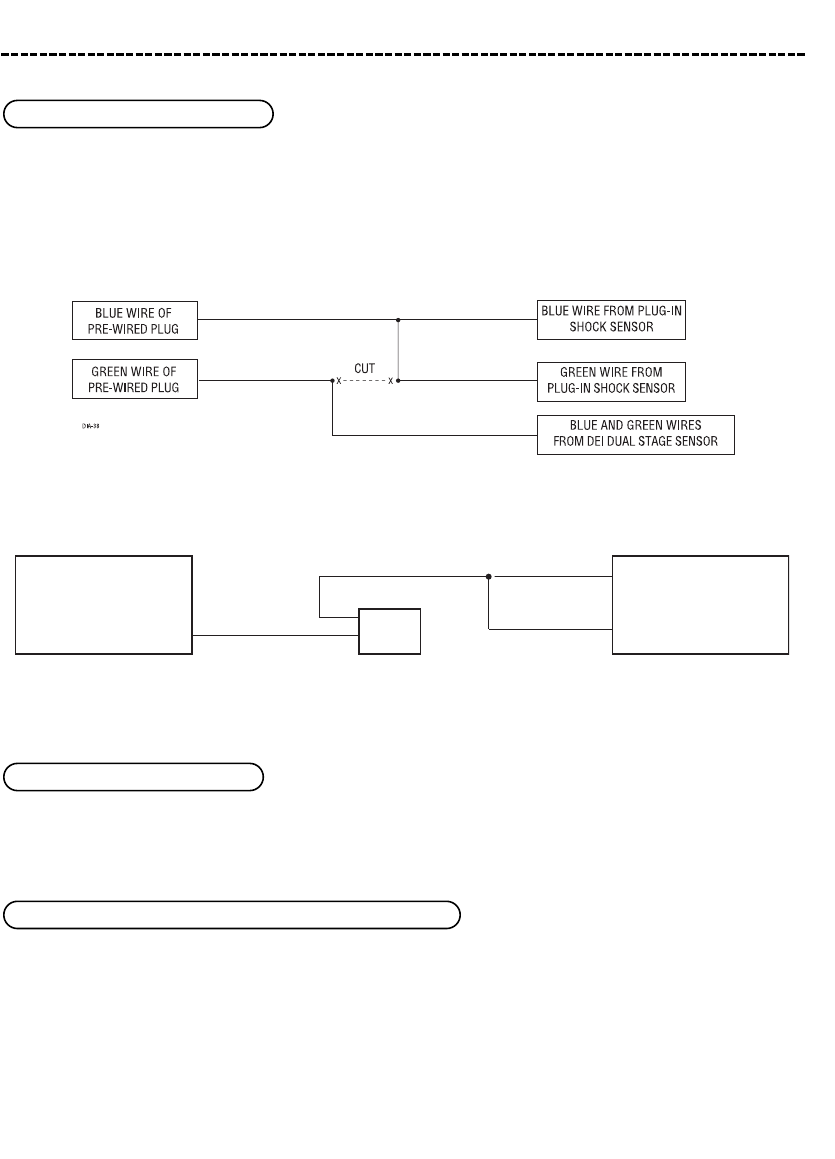
© 2004 Directed Electronics, Inc. Vista, CA 3333
sshhoocckk sseennssoorr hhaarrnneessss,, 44--ppiinn ccoonnnneeccttoorr
Inputs shorter than 0.8 seconds will trigger the Warn Away® response, while inputs longer than 0.8 seconds will
trigger full alarm sequence and report Zone Two. If installing an optional Directed Electronics dual stage sensor,
connect to the green wire as shown below. The diagram below eliminates the need for diodes to isolate the sensors.
DDiiaaggrraamm ffoorr aaddddiinngg ooppttiioonnaall DDiirreecctteedd EElleeccttrroonniiccssdduuaall ssttaaggee sseennssoorr ttoo ggrreeeenn wwiirree ((ZZoonnee 22))::
Inputs shorter than 0.8 seconds will trigger the Warn Away® response, while inputs longer than 0.8 seconds will
trigger full alarm sequence and will also report Zone Two.
Do not use these for anything besides the plug-in shock sensor.
NNOOTTEE:: If adding additional sensor(s), connect the power and ground of the additional sensor(s)
to the power and ground at the 12-pin harness.
RREEDD aanndd BBLLAACCKK:: RREEDD iiss ((++))1122VV ccoonnssttaanntt,, BBLLAACCKK iiss ((--)) ggrroouunndd
BBLLUUEE ((--)) mmuullttiipplleexx iinnppuutt,, zzoonnee 22
504D 508D
BLUE
GREEN
GREEN
BLUE
Shock Sensor Field Disturbance Sensor
Plug to Control Module
GGRREEEENN ((--)) mmuullttiipplleexx iinnppuutt,, zzoonnee 22
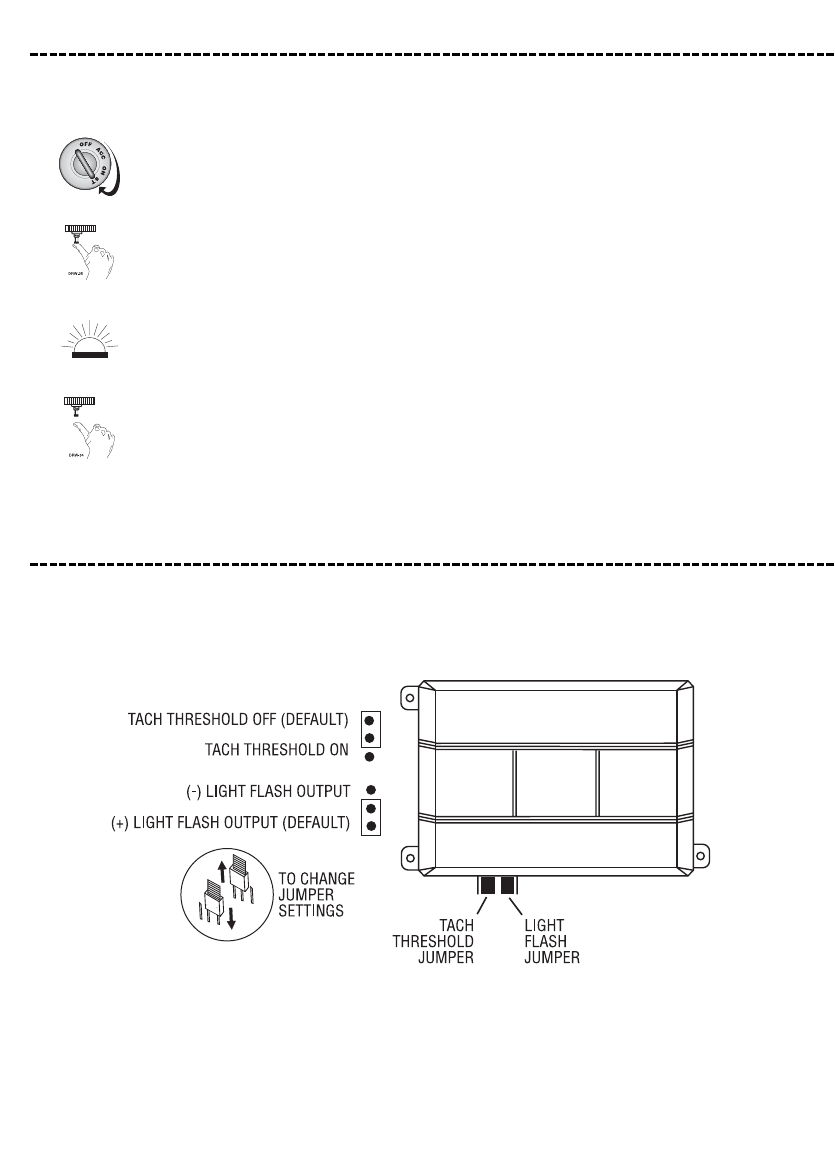
3344© 2004 Directed Electronics, Inc. Vista, CA
ttaacchh lleeaarrnniinngg
TToo lleeaarrnn tthhee ttaacchh ssiiggnnaall::
1. Start the vehicle with the key.
2. Within 5 seconds, press and HHOOLLDDthe Valet®/Program switch.
3. The LED will light constant when the tach signal is learned.
4. Release the Valet®/Program switch.
pprrooggrraammmmiinngg jjuummppeerrss
DRW-96

© 2004 Directed Electronics, Inc. Vista, CA 3355
In most cases, this jumper can be left in the OFF position. Some new vehicles use less than 12 volts in their
ignition systems. The unit may have trouble learning the tach signal in these vehicles. Changing the jumper to
the ON setting changes the trigger threshold of the digital tach circuit so it will work properly with these vehi-
cles. These vehicles include many newer Dodge/Chrysler/Plymouths, such as the Neon Cirrus/Stratus/Breeze and
LH-based cars.
This jumper is used to determine the light flash output. In the (+) position, the on-board relay is enabled and
the unit will output (+)12V on the WHITE wire, H1/2. In the (-) position, the on-board relay is disabled. The
WHITE wire, H1/2, will supply a 200 mA (-) output suitable for driving factory parking light relays.K
NNOOTTEE::For parking light circuits that draw 10 amps or more, the internal jumper must be switched
to a (-) light flash output. PP//NN 88661177or a standard automotive SPDT relay must be used on the
H1/2 light flash output harness wire.
ttrraannssmmiitttteerr//rreecceeiivveerr lleeaarrnn rroouuttiinnee™™
The system comes with one transmitter that has been taught to the receiver. The receiver can store up to four
different transmitter codes in memory. Use the following learn routine to add transmitters to the system or to
change button assignments if desired.
Using the optional Directed Electronics Bitwriter™, the learn routine may be locked. Make sure the learn routine is
unlocked before programming features. If the siren generates one long chirp when attempting to program the unit,
the learn routine is locked and must be unlocked using the Directed Electronics Bitwriter™ before proceeding.
The Valet®/Program button, plugged into the blue port, is used for programming. There is a basic sequence to
remember whenever programming this unit: Door, Key, Choose, Transmit and Release.
1. OOppeenn aa ddoooorr.. (The GREEN wire, H1/5, or the VIOLET, H1/7 must be connected.)
2. KKeeyy.. Turn the ignition on. (The heavy gauge PINK wire of the relay satellite must be con-
nected.)
lliigghhtt ffllaasshh ((++))//((--))
ttaacchh tthhrreesshhoolldd oonn//ooffff

3366© 2004 Directed Electronics, Inc. Vista, CA
3. SSeelleecctt tthhee rreecceeiivveerr cchhaannnneell..Press and release the Valet®/Program switch the number of
times necessary to access the desired channel. Once you have selected a channel, press
and HHOOLLDDthe Valet®/Program switch once more. The siren will chirp and the LED will blink
the number of times corresponding to the channel that has been accessed.
CChhaannnneellss TTwwoo——1111:: These channels can be used to program the remote control with customized button configu-
rations. This can be useful for users with multiple vehicles that have identical systems.
CChhaannnneell TTwweellvvee:: If any transmitter button from a known transmitter is programmed to Channel Twelve, all trans-
mitters will be erased from memory and will revert to the default feature settings. (See
Features Menu
section of
this guide.) This is useful in cases when one of the customer's transmitters is lost or stolen. This will erase any
lost or stolen transmitters from the system's memory. It can also be used to start from scratch if the transmitter
buttons were programmed incorrectly.
4. PPrreessss tthhee ttrraannssmmiitttteerr bbuuttttoonn..While HHOOLLDDIINNGGthe Valet®/Program switch, press the button
from the transmitter that you wish to assign to that channel. The unit will chirp indicat-
ing successful programming. It is not possible to teach a transmitter button to the system
more than once.
5. RReelleeaassee..Once the code is learned, the Valet®/Program button can be released.
You can advance from one channel to another by releasing the Valet®/Program button and tapping it to advance
channels and then HHOOLLDDIINNGGit. For example, if you want to program Channel Three after programming Channel One,
CCHHAANNNNEELL NNUUMMBBEERRFFUUNNCCTTIIOONNWWIIRREE CCOOLLOORR
1 Auto Learn Standard Configuration**(default)
2 Arm only
3 Disarm only
4 Silent Mode™/Remote Valet®/Trunk Release RED/WHITE
5 Remote Start
6 Channel 4 VIOLET/BLACK
7 Channel 5 WHITE/BLACK
8 Short Run/Turbo
9 Timer Mode
10 Arm/Disarm/Panic
11 Panic only
12 Delete all transmitters
**NNOOTTEE:: For Auto Learn Configurations, see Transmitter Configurations section of this guide.
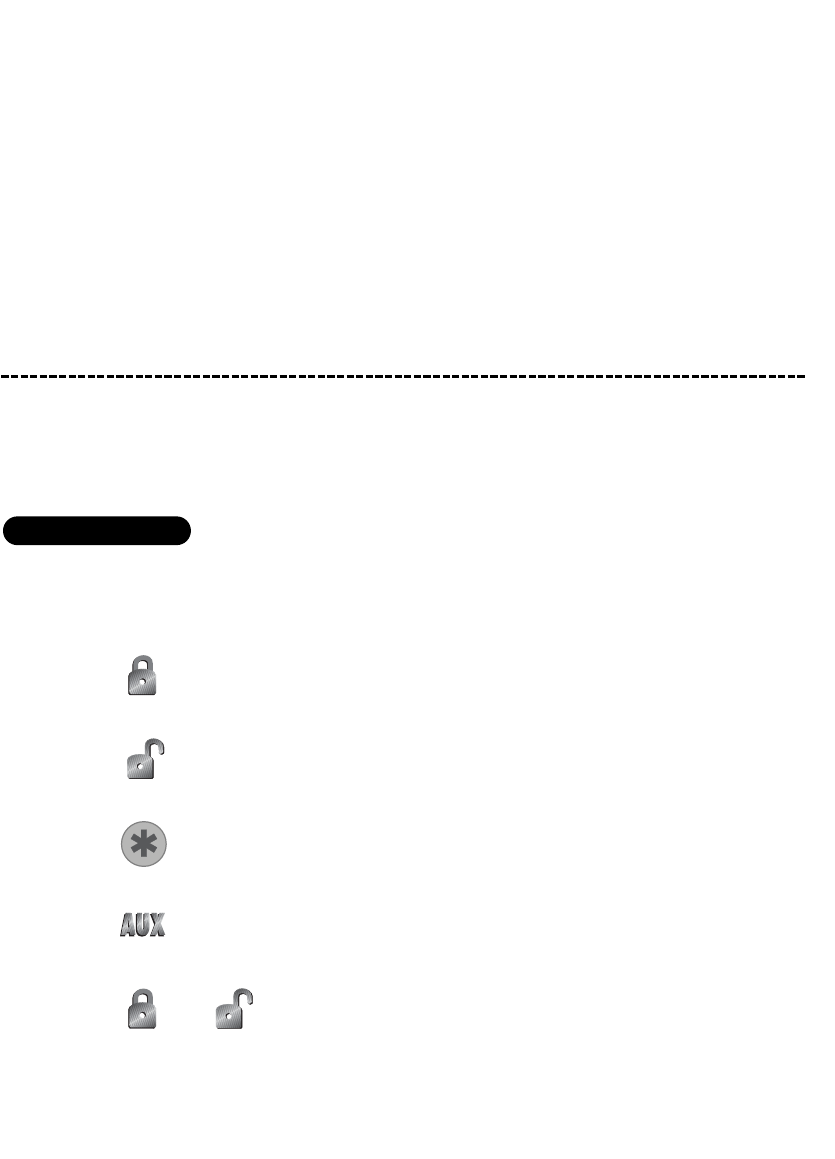
© 2004 Directed Electronics, Inc. Vista, CA 3377
release the Valet®/Program button. Press it twice and release it to advance to Channel Three. Then press it once
more and HHOOLLDDit. The siren will chirp three times to confirm it is ready to receive the code from the transmitter.
Learn Routine™ will be exited if:
■Ignition is turned off.
■Door is closed.
■Valet®/Program button is pressed too many times.
■More than 15 seconds elapses between steps.
One long chirp indicates that Learn Routine™ has been exited.
ttrraannssmmiitttteerr ccoonnffiigguurraattiioonnss
The transmitters can be programmed with the standard or custom configurations by using the
Transmitter/Receiver Learn Routine.
A remote that uses the standard configuration operates similarly to many factory keyless entry remotes. A stan-
dard configuration transmitter allows arming, disarming, and Panic Mode activation with separate buttons. When
programmed for standard configuration, the transmitter buttons are assigned to the following functions:
.................................operates...........................Arm/Lock,
Panic ON/Panic OFF
.................................operates...........................Disarm/Unlock,
/Panic OFF
.................................operates...........................Start
.................................operates...........................Channel 2—trunk
release
and ................operate............................Timer Mode
ssttaannddaarrdd ccoonnffiigguurraattiioonn

3388© 2004 Directed Electronics, Inc. Vista, CA
and ................operate ..........................Short Run/Turbo
timer
and ................operate............................Channel 4
and ................operate............................Channel 5
The standard configuration also allows the user to utilize Multi-Level Security Arming (described in the follow-
ing section).
NNOOTTEE::Refer to the Owner’s Guide for specific transmitter notifications and transmitter usage.
ssyysstteemm ffeeaattuurreess lleeaarrnn rroouuttiinnee
The System Features Learn Routine dictates how the unit operates. It is possible to access and change any of
the feature settings using the Valet/program switch. However, this process can be greatly simplified by using the
optional Bitwriter (pp//nn 999988TT). Any of the settings can be changed and then assigned to one of up to four trans-
mitters. This feature is called Owner Recognition. Each time that particular transmitter is used to disarm the
system, the assigned feature settings will be recalled. Owner Recognition is only possible when programming the
unit via the hand-held programmer.
If programming with the Bitwriter (pp//nn 999988TT), the learn routine can be locked or unlocked. If the learn
routine has previously been locked, it must be unlocked before proceeding with reprogramming the learn
routine. This must be done by using pp//nn 999988TT- this cannot be done manually with the Valet switch. If the learn
routine is locked, features cannot be changed.
TToo eenntteerr tthhee SSyysstteemm FFeeaattuurreess LLeeaarrnn RRoouuttiinnee™™::
1. OOppeenn aa ddoooorr.. ((The GREEN wire, H1/5, or the VIOLET, H1/7 must be connected.)
2. IIggnniittiioonn.. Turn the ignition on, then back off. (The heavy gauge PINK wire of the relay
satellite must be connected.)

© 2004 Directed Electronics, Inc. Vista, CA 3399
3. SSeelleecctt aa MMeennuu..Press and HHOOLLDDthe Valet®/Program switch. (The Valet®/Program switch
must be plugged into the blue port.) After three seconds the siren will chirp once indi-
cating entry to the Basic Features Menu. If this is the menu you wish to access, release
the button and go on to Step 4. If the button is not released, you will jump to the next
menu and the siren will chirp twice. There are three possible menus. Once you have
selected the desired menu, release the Valet®/Program switch.
4. SSeelleecctt aa FFeeaattuurree.. Press and release the Valet®/Program switch the number of times corre-
sponding to the feature you wish to change. For example, to access the third feature, press
and release 3 times. Then press the button once more and HHOOLLDDit. The siren will chirp the
number of times equal to the feature you have accessed.
5. PPrrooggrraamm tthhee FFeeaattuurree.. While holding the Valet®/Program switch, you can toggle the feature
on and off using the remote transmitter. Pressing the button that arms the system will
select the one chirp or default setting. Pressing the button that disarms the system (or the
Channel Two button when in the single button arm/disarm configuration) will select the
two chirp setting.
NNOOTTEE::Some features have more than two possible settings. Pressing Channel One will select the
one chirp setting, pressing Channel Two will toggle through the two-chirp and higher settings.)
6. RReelleeaassee.. Release the Valet®/Program switch.
OOnnccee aa ffeeaattuurree iiss pprrooggrraammmmeedd::
■Other features can be programmed within the same menu.
■Another menu can be selected.
■The learn routine can be exited if programming is complete.
TToo aacccceessss aannootthheerr ffeeaattuurree iinn tthhee ssaammee mmeennuu::
1. Press and release the Valet®/Program switch the number of times necessary to advance from the feature you
just programmed to the next one you want to program.
2. Then press the Valet®/Program switch once more and HHOOLLDDit.
For example, if you just programmed the third feature in the menu and you would like to program the seventh
feature in the menu, you would press and release the Valet®/Program switch four times and then press it once
more and HHOOLLDDit. The siren would chirp seven times to confirm access to the seventh feature.
TToo sseelleecctt aannootthheerr mmeennuu::
1. Press and hold the Valet®/Program switch.
2. After three seconds, the unit will advance to the next menu and the siren will chirp, indicating which menu
has been accessed.

4400© 2004 Directed Electronics, Inc. Vista, CA
For example, if you just programmed some features in the first menu and you want to program a feature in the
third menu, press and HHOOLLDDthe Valet®/Program switch. After three seconds, the siren chirps twice indicating
access to the second menu. Continue to HHOOLLDDthe button and three seconds later the siren will chirp three times
indicating access to the third menu. Features in the third menu are then programmable following steps 4 through
6 of the System Features Learn Routine procedure.
TToo eexxiitt tthhee lleeaarrnn rroouuttiinnee::
The learn routine will be exited if any of the following occurs:
1. Close the open door.
2. Turn the ignition on.
3. There is no activity for longer than 15 seconds.
4. The Valet®/Program switch is pressed too many times.
ffeeaattuurree mmeennuuss
The default settings are indicated in bboollddtype. Features that have additional settings that can be programmed
using the Bitwriter are indicated with an asterisk (*).
FFEEAATTUURREE NNUUMMBBEERROONNEE--CCHHIIRRPP SSEETTTTIINNGG ((DDEEFFAAUULLTT))TTWWOO--CCHHIIRRPP SSEETTTTIINNGG
1-1 AAccttiivvee aarrmmiinnggPassive arming
1-2 AArrmm//ddiissaarrmm cchhiirrppss oonnArm/disarm chirps off
1-3 IIggnniittiioonn--ccoonnttrroolllleedd ddoooorr lloocckkss**Standard door locks*
1-4 IIggnniittiioonn--ccoonnttrroolllleedd uunnlloocckk OONNStandard unlock
1-5 AAccttiivvee lloocckkiinngg oonnllyyPassive locking
1-6 PPaanniicc wwiitthh iiggnniittiioonn oonnNo panic with ignition on
1-7 00..88 sseeccoonndd ddoooorr lloocckk ppuullsseess3.5 second door lock pulses
1-8 FFoorrcceedd ppaassssiivvee aarrmmiinngg oonnForced passive arming off
1-9 Automatic engine disable on AAuuttoommaattiicc eennggiinnee ddiissaabbllee ooffff
1-10 AArrmmeedd WWhheenn DDrriivviinngg ((AAWWDD)) oonnAWD off
1-11 CCooddee HHooppppiinngg oonnCode Hopping off
mmeennuu ##11 -- bbaassiicc ffeeaattuurreess

© 2004 Directed Electronics, Inc. Vista, CA 4411
FFEEAATTUURREEOONNEE--CCHHIIRRPP SSEETTTTIINNGG ((DDEEFFAAUULLTT))TTWWOO--CCHHIIRRPP SSEETTTTIINNGG
3-1 EEnnggiinnee cchheecckkiinngg OONNEngine checking OFF
3-2 EEnnggiinnee cchheecckkiinngg TTAACCHHEngine checking VOLTAGE
3-3 RRuunn ttiimmee:: 1122 mmiinnuutteess**Run time: 24 or 60 minutes*
3-4 PPaarrkkiinngg lliigghhttss ffllaasshhiinnggParking lights constant
3-5 CCrraannkk ttiimmee:: 00..66 sseeccoonnddss0.8, 1.0, 1.2, 1.6, 1.8, 2.0, 4.0 sec.
3-6 VVoollttaaggee cchheecckk -- hhiigghhVoltage check - low
3-7 SSttaarrtt RRuunn//TTuurrbboo––11 mmiinn..3, 5, 10 min.
3-8 Activation pulse count–1 AAccttiivvaattiioonn ppuullssee ccoouunntt:: 22
3-9 22nnddIIggnniittiioonn//AAcccceessssoorryy oouuttppuutt:: iiggnniittiioonnAccessory
3-10 AAcccceessssoorryy ssttaattee dduurriinngg ssttaarrtt:: OONNOFF
3-11 22nnddssttaattuuss oouuttppuutt:: NNoorrmmaallRear defogger: latch 5 min./pulse OFF
3-12 AAnnttii ggrriinndd:: OONNAnti grind: OFF
mmeennuu ##33 -- rreemmoottee ssttaarrtt ooppttiioonnss
FFEEAATTUURREE NNUUMMBBEERROONNEE--CCHHIIRRPP SSEETTTTIINNGG ((DDEEFFAAUULLTT))TTWWOO--CCHHIIRRPP SSEETTTTIINNGG
2-1 SSiirreenn oouuttppuutt ccoonnssttaannttSiren output pulsed
2-2 3300 sseeccoonndd ssiirreenn dduurraattiioonn**60 second siren duration*
2-3 NNuuiissaannccee PPrreevveennttiioonn CCiirrccuuiittrryy oonnNuisance Prevention Circuitry OFF
2-4 PPrrooggrreessssiivvee ddoooorr ttrriiggggeerrInstant door trigger
2-5 DDiissaarrmm ffrroomm VVaalleett,, 11 ppuullsseeDisarm from Valet, 2-5 pulses
2-6 DDoooorr sseennssoorr bbyyppaassss cchhiirrpp oonnDoor sensor bypass chirp OFF
2-7 IIggnniittiioonn ccoonnttrroolllleedd ddoommeelliigghhtt oonnIgnition controlled domelight OFF
2-8 SSiinnggllee uunnlloocckk ppuullsseeDouble unlock pulse
2-9 FFaaccttoorryy ddiissaarrmm wwiitthh CChhaannnneell TTwwoo oonnFactory disarm with Channel Two OFF
2-10 CChhaannnneell FFoouurr vvaalliiddiittyyChannel Four: latched/latched, reset
with ignition/30-second timed
2-11 CChhaannnneell 55 VVaalliiddiittyyChannel Five: latched/latched, reset
with ignition/30-second timed
mmeennuu ##22 -- aaddvvaanncceedd ffeeaattuurreess

4422© 2004 Directed Electronics, Inc. Vista, CA
ffeeaattuurree ddeessccrriippttiioonnss
The features of the system are described below. Features that have additional settings that can be selected only
when programming with the Bitwriter are indicated by the following icon:
11--11 AACCTTIIVVEE//PPAASSSSIIVVEE AARRMMIINNGG::When active arming is selected, the system will only arm when the transmitter is
used. When set to passive, the system will arm automatically 30 seconds after the last door is closed. To alert
the consumer of passive arming, the siren will chirp 20 seconds after the door is closed. This provides the con-
sumer with an audible warning prior to the system actually arming. At the 30 second mark, the system will arm,
but the siren will not chirp.
11--22 CCHHIIRRPPSS OONN//OOFFFF:: This feature controls the chirps that confirm the arming and disarming of the system.
11--33 IIGGNNIITTIIOONN CCOONNTTRROOLLLLEEDD DDOOOORR LLOOCCKKSS OONN//OOFFFF:: When turned on, the doors will lock three seconds after the igni-
tion is turned on and unlock when the ignition is turned off. There are separate steps for ignition lock and
ignition unlock. They can be programmed on or off independently.
11--44 IIGGNNIITTIIOONN CCOONNTTRROOLLLLEEDD UUNNLLOOCCKK::When turned ON the doors will unlock when the ignition is turned OFF.
11--55 AACCTTIIVVEE//PPAASSSSIIVVEE LLOOCCKKIINNGG::If passive arming is selected in Feature 1-1, then the system can be programmed
to either lock the doors when passive arming occurs, or only lock the doors when the system is armed via the
transmitter. Active locking means the system will not lock the doors when it passively arms. Passive locking
means that the system will lock the doors when it passively arms.
NNOOTTEE::Remember, when passive arming is selected, the unit will chirp 20 seconds after the last
door is closed. The system does not actually arm or lock the doors until 30 seconds after the
door has been closed.
11--66 PPAANNIICC WWIITTHH IIGGNNIITTIIOONN OONN:: This feature controls whether or not the panic mode is available with the igni-
tion on. In some states, there are laws prohibiting a siren sounding in a moving vehicle. This feature makes the
system compliant with these regulations.
11--77 DDOOOORR LLOOCCKK PPUULLSSEE DDUURRAATTIIOONN::Some European vehicles, such as Mercedes-Benz and Audi, require longer lock
and unlock pulses to operate the vacuum pump. Programming the system to provide 3.5 second pulses, will
accommodate the door lock interface in these vehicles. The default setting is 0.8 second door lock pulses. Some
modification to the door lock harness (H2) is also necessary. (See
(+/-) Door Lock Outputs Harness (H4)
section,
"Type E - Mercedes-Benz and Audi -1985 and Newer" diagram.)
mmeennuu ##11 -- bbaassiicc ffeeaattuurreess

© 2004 Directed Electronics, Inc. Vista, CA 4433
11--88 FFOORRCCEEDD PPAASSSSIIVVEE AARRMMIINNGG OONN//OOFFFF::To use this feature, passive arming must be selected in Feature 1-1. When
turned on, forced passive arming will ensure that the system will passively arm, even if a zone is left open or
invalid. Forced passive arming occurs one hour after the ignition is turned off.
11--99 AAUUTTOOMMAATTIICC EENNGGIINNEE DDIISSAABBLLEE ((AAEEDD)) OONN//OOFFFF: AED is a full-time, passive starter disable that works independ-
ently of the security system. When turned on, the orange, ground-when-armed output (H1/1) will activate 30
seconds after the ignition is turned off. The LED will flash at half its normal rate when the ignition is turned off
to indicate that AED is active and will interrupt the starter in 30 seconds. AED does not occur in Valet® mode
and can be bypassed using the emergency override procedure. The transmitter can be used to disarm AED,
however, the system must be armed and then disarmed, using the transmitter, to disarm AED.
11--1100 AARRMMEEDD WWHHIILLEE DDRRIIVVIINNGG ((AAWWDD)) OONN//OOFFFF::In the default setting (Armed While Driving), the system can be
armed with the ignition on. When armed, the ground-when-armed is not active and the sensors are bypassed.
The door triggers will remain active.
11--1111 CCOODDEE HHOOPPPPIINNGG™™ OONN//OOFFFF::The system uses a mathematical formula to change its code each time the trans-
mitter and receiver communicate. This makes the group of bits or "word" from the transmitter very long. The
longer the word is, the easier it is to block its transmission to the unit. Disabling the Code Hopping™ feature
lets the receiver ignore the Code Hopping™ part of the transmitted word. As a result, the unit may have better
range with Code Hopping™ off.
22--11 SSIIRREENN OOUUTTPPUUTT CCOONNSSTTAANNTT//PPUULLSSEEDD::The system can be programmed to output pulses instead of a continuous
output when the system is triggered. This is useful to honk the factory horn in applications where a siren is unde-
sirable. Remember that the unit is only capable of supplying 1 amp of current. A relay will be required to interface
with most factory horn systems.
22--22 SSIIRREENN DDUURRAATTIIOONN 3300//6600 SSEECCOONNDDSS::It is possible to program the unit to sound for 30 or 60 seconds
during the triggered sequence. Some states have laws regulating how long a security system can sound.
When using the TechSoft Programmer or Bitwriter™, the siren can be programmed to sound for any length of time
from 1 second to 180 seconds. Use the right and left arrows or the plus (+) and minus (-) keys on your keyboard
to change the siren duration in 1 second intervals. Holding down the key will rapidly increase or decrease the setting.
The desired siren duration can also be directly entered by using the number keys on your computer's keyboard.
22--33 NNUUIISSAANNCCEE PPRREEVVEENNTTIIOONN CCIIRRCCUUIITTRRYY™™ ((NNPPCC™™)) OONN//OOFFFF::NPC™ stops repeated triggering of the same zone. If
one zone is triggered three times in one hour, that zone is bypassed for one hour, starting from the time of the
third trigger. During that hour, if the system sees a trigger on that zone again, the system resets the one hour
timer. If one hour passes and the zone has not triggered again, the zone is activated and can trigger the system
again. NPC™ only monitors sensor inputs, and does not bypass the door trigger or the ignition trigger at any
time. If NPC™ is turned off, the system will respond to repeated triggers on the sensor inputs and will do so
mmeennuu ##22 -- aaddvvaanncceedd ffeeaattuurreess

4444© 2004 Directed Electronics, Inc. Vista, CA
indefinitely. Some states have laws regulating how many times a security system can trigger before it is consid-
ered a nuisance and the vehicle is towed away.
22--44 PPRROOGGRREESSSSIIVVEE DDOOOORR TTRRIIGGGGEERR OONN//OOFFFF::The system responds to a door trigger input with a progressive
response. When the door is opened with the system armed, the siren will chirp 10 times prior to the full trig-
gered sequence. The door trigger is still treated as an instant trigger and closing the door quickly will not prevent
full triggered sequence from occurring. If the progressive door trigger is programmed off, the full siren output
will occur the moment the door is opened.
22--55 VVAALLEETT PPUULLSSEE CCOOUUNNTT 11 TTOO 55 PPUULLSSEESS::The system can be programmed to count the number of presses of the
valet switch before disarming the security system. The factory default setting is one pulse. The unit can also be
set for two to five pulses.
Ghost Switch option: For added security, the GRAY wire on the two-pin Valet®/Program plug can be connected
to any switch in the vehicle that provides a positive (+) momentary pulse.
22--66 DDOOOORR SSEENNSSOORR BBYYPPAASSSS CCHHIIRRPP OONN//OOFFFF::This feature controls the error chirp that is generated if the system is
armed with the door trigger active. This is useful in vehicles that have a long dome light delay after the door
has been closed. If the system is armed before the dome light has turned off, the security system will generate
the door trigger error chirp. If this error chirp is not desired, use this feature to disable the door open error chirp.
If the bypass chirp is turned off, no bypass chirp will be generated, even if a door is accidentally left open.
22--77 IIGGNNIITTIIOONN CCOONNTTRROOLLLLEEDD DDOOMMEE LLIIGGHHTT SSUUPPEERRVVIISSIIOONN OONN//OOFFFF::If turned on, the system will turn on the dome
light for 60 seconds when the ignition is turned off. The optional dome light supervision feature must be installed
as described in the Wire Connection Guide.
22--88 DDOOUUBBLLEE PPUULLSSEE UUNNLLOOCCKK OONN//OOFFFF::Some vehicles require two pulses on a single wire to unlock the doors. When
the double pulse unlock feature is turned on, the BLUE H4/C wire will supply two negative pulses instead of a
single pulse. At the same time, the GREEN H4/A wire will supply two positive pulses instead of a single pulse.
This makes it possible to directly interface with double pulse vehicles without any extra parts.
22--99 FFAACCTTOORRYY AALLAARRMM DDIISSAARRMM WWIITTHH CCHHAANNNNEELL 22::In the default setting the factory alarm disarm output will disarm
the factory alarm system any time the button(s) controlling Channel Two is pressed.
22--1100 CCHHAANNNNEELL 44 VVAALLIIDDIITTYY//LLAATTCCHHEEDD//LLAATTCCHHEEDD RREESSEETT WWIITTHH IIGGNNIITTIIOONN//3300 SSEECCOONNDD TTIIMMEEDD:: Channel Four can be pro-
grammed for these output configurations. The unit is set to the default validity output. To change the
configuration, use the two-chirp setting to toggle through the different configurations.

© 2004 Directed Electronics, Inc. Vista, CA 4455
22--1111 CCHHAANNNNEELL 55 VVAALLIIDDIITTYY//LLAATTCCHHEEDD//LLAATTCCHHEEDD RREESSEETT WWIITTHH IIGGNNIITTIIOONN//3300 SSEECCOONNDD TTIIMMEEDD:: Channel Four can be pro-
grammed for these output configurations. The unit is set to the default validity output. To change the
configuration, use the two-chirp setting to toggle through the different configurations.
33--11 EENNGGIINNEE CCHHEECCKKIINNGG OONN//OOFFFF::In the default setting the remote start will monitor either the vehicle's tach wire
or voltage depending on the programming of feature 3-2. If programmed OFF the vehicle will crank for the pro-
grammed crank time (feature 3-5) and will not verify with tach or voltage that the car is running. In the OFF
setting, if the vehicle fails to start, the ignition can stay on for the entire run duration. Using tach or voltage
check is always recommended if possible.
33--22 CCHHEECCKKIINNGG TTYYPPEE TTAACCHH//VVOOLLTTAAGGEE::Selects the method of engine monitoring. If set to TACHOMETER the unit will
reference the learned tach signal to disengage the starter. In addition it will monitor the RPM and shut down if
the engine RPM is too high or too low. When set to VOLTAGE, the unit will crank the starter for the programmed
time and then attempt to sense that the engine is running by detecting an increase in voltage. The threshold
for the voltage check is selectable in feature 3-6.
33--33 RRUUNN TTIIMMEE 1122,, 2244,, 6600 MMIINNUUTTEESS::Selects the time in minutes that the system will operate the engine until
the system "times out". This is the maximum operation period and the system may be shut down using a
shutdown at any time. Using the Bitwriter, the run time can be programmed for any duration from 1-60 minutes.
33--44 PPAARRKKIINNGG LLIIGGHHTTSS FFLLAASSHHIINNGG//CCOONNSSTTAANNTT:: In the default setting, the unit will flash the vehicle's parking lights (if
connected) while remote started. The constant setting will turn the parking lights on solid for the entire run duration.
33--55 CCRRAANNKK TTIIMMEE 00..66//00..88//11..00//11..22//11..44//11..66//11..88//22..00//44..00 SSEECCOONNDDSS::If the unit is programmed for no engine check-
ing or voltage sense, the crank time must be set to the appropriate duration. The default setting is 0.6 second.
If a different crank time is desired, select feature 3-5 and select either 0.6 second by using the one-chirp setting
or toggle through the higher settings by using the two-chirp settings.
33--66 VVOOLLTTAAGGEE CCHHEECCKK HHII//LLOOWW::This feature only functions when programmed for voltage sense. Some vehicles have
many accessories, which are turned on when remote started. In these vehicles, the variation of voltage between
the engine off and the car running is very small and the remote start unit may "think" the vehicle has not started.
This can cause the remote start to shut-down after the car has been started. If this happens program this feature
to the LOW position.
33--77 SSHHOORRTT RRUUNN//TTUURRBBOO:: When the and buttons on the transmitter are pressed simultaneously, the
vehicle will start for the programmed short run time. The factory default is 1 minute.
mmeennuu ##33 -- rreemmoottee ssttaarrtt ooppttiioonnss

4466© 2004 Directed Electronics, Inc. Vista, CA
33--88 AACCTTIIVVAATTIIOONN PPUULLSSEE CCOOUUNNTT::This allows the system to use 1 or 2 pulses to activate the remote start sequence.
NNoottee!!1 or 2 pulses on the WHITE/BLUE remote start activation input wire as well as the
button of the remote control.
33--99 22nnddIIGGNNIITTIIOONN//22nnddAACCCCEESSSSOORRYY OOUUTTPPUUTT::This will allow the PINK/WHITE to be used as a 2nd ignition or an
accessory.
33--1100 AACCCCEESSSSOORRYY SSTTAATTEE DDUURRIINNGG WWAAIITT--TTOO--SSTTAARRTT::This feature will allow the selection of the accessory output to
be ON or OFF during wait-to-start.
33--1111 22nndd SSTTAATTUUSS OOUUTTPPUUTT::This feature will allow selection of status output or a rear defogger mode that turns
on ten seconds after the vehicle has started. The defogger mode has two selections, latched or pulsed. Latched
mode will only stay on for 5 minutes.
33--1122 AANNTTII--GGRRIINNDD OONN//OOFFFF::With the anti-grind On (default) the ground-when-armed output will be active during
remote start operation. If accessories such as a voice module or window module are added to the unit, it may be
necessary to program this feature off.
nnuuiissaannccee pprreevveennttiioonn cciirrccuuiittrryy™™
NPC™ requires that you change the way you test the system as NPC™ will bypass an input zone for 60 minutes.
If the system “sees” the same zone trigger three times AND the triggers are spaced less than an hour apart, the
system will bypass that input zone for 60 minutes. If that zone does not attempt to trigger the system during
the 60-minute bypass period, the zone’s monitoring will begin again at the end of the hour. If it does attempt
to trigger while bypassed, the 60-minute bypass starts over again.
Disarming and rearming the system does not reset NPC™. The only way to reset NPC™ is for the 60 minutes to
pass, without a trigger, or for the ignition to be turned on. This allows the system to be repeatedly triggered,
disarmed and rearmed, and still allow NPC™ to bypass a faulty zone.
When disarming the system, 5 chirps indicate NPC is activated. The LED will report the zone that has been
bypassed. (See
Diagnostics
section of this guide.)

© 2004 Directed Electronics, Inc. Vista, CA 4477
vvaalleett mmooddee
TToo eenntteerr oorr eexxiitt vvaalleett mmooddee wwiitthh tthhee vvaalleett//pprrooggrraamm sswwiittcchh::
1. Turn the ignition key on and then off.
2. At anytime during the next 10 seconds, press and release the Valet® switch. Now the Status
LED will light constantly if you have entered Valet® Mode, and go out if you have exited
Valet® Mode.
TToo eenntteerr oorr eexxiitt vvaalleett mmooddee wwiitthh tthhee ttrraannssmmiitttteerr::
To enter or exit Valet® Mode with a transmitter:
1. Open any door.
2. Press on the transmitter.
3. Press .
4. Press again. You have now entered or exited Valet Mode (verify by checking your status LED).
ttiimmeerr mmooddee
This unit can be programmed to start and run the engine every three hours, for a maximum of six cycles. The
engine will run for the programmed run time and then shut down. After three hours, the system will restart the engine.
IIMMPPOORRTTAANNTT!!Timer Mode should be used only in open areas. Never start and run the vehicle in
an enclosed space such as a garage or carport.
TToo eenntteerr oorr eexxiitt ttiimmeerr mmooddee wwiitthh tthhee ttrraannssmmiitttteerr::
The same procedure may be used to enter or exit Timer Mode using the remote transmitter:
1. Remote start the vehicle by pressing and simultaneously.
2. The lights will flash 4-times.
3. After 1-second the car will start and the timer mode will run for the specified time period.
The system is in Timer Mode. The engine may be allowed to run for its programmed run time, or the transmitter
can be used to shut down the engine. Either way, the remote start system will restart the engine again in three
hours. Timer Mode is exited automatically after the sixth run cycle.

4488© 2004 Directed Electronics, Inc. Vista, CA
TToo eenntteerr oorr eexxiitt ttiimmeerr mmooddee mmaannuuaallllyy::
1. Make sure the remote start system is not operating the engine.
2. Turn the ignition on.
Timer Mode will be exited and the parking lights will flash four times.
ttaabbllee ooff zzoonneess
When using the Diagnostic functions, use the Table of Zones to see which input has triggered the system. It is
also helpful in deciding which input to use when connecting optional sensors and switches.
NNOOTTEE: The Warn Away® response does not report on the LED.
sshhuuttddoowwnn ddiiaaggnnoossttiiccss
1. With the ignition OFF, press and HHOOLLDDthe Valet/Program button.
2. Turn the ignition ON and then back OFF while HHOOLLDDIINNGGthe Valet/Program button.
3. Release the Valet/Program button.
4. Press and release the Valet/Program button. The LED will report the last shutdown for one minute or until
the ignition is turned on.
ttoo ppeerrffoorrmm sshhuuttddoowwnn ddiiaaggnnoossttiiccss
ZZOONNEE NNOO..TTRRIIGGGGEERR TTYYPPEEIINNPPUUTT DDEESSCCRRIIPPTTIIOONN
1 Multiplexed Input BLUE (H1/6)
2 Multiplexed Shock Sensor Input Mux BLUE wire
3 Door Trigger GREEN (H1/5) and VIOLET (H1/7)
4 Multiplexed Shock Sensor Mux GREEN wire
5 Ignition Yellow ribbon harness wire
6 Hood Trigger GRAY on the 6-pin shutdown harness
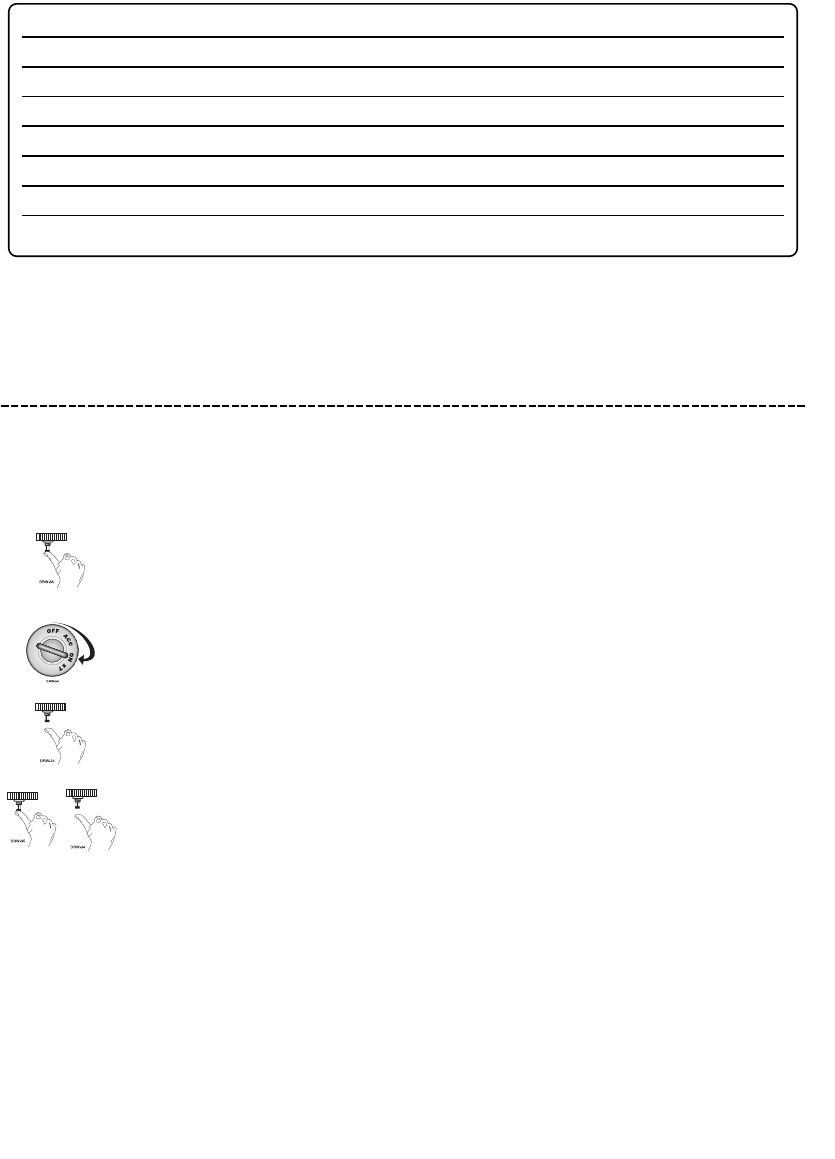
© 2004 Directed Electronics, Inc. Vista, CA 4499
lloonngg tteerrmm eevveenntt hhiissttoorryy
The system stores the last two full triggers in memory. These are not erasable. Each time the unit sees a full trigger,
the older of the two triggers in memory will be replaced by the new trigger. To access long term event history:
1. With the ignition off, press and HHOOLLDDthe Valet®/Program switch.
2. Turn on the ignition.
3. Release the Valet®/Program switch.
4. Press and release the Valet®/Program switch within 5 seconds. The LED will flash in groups
indicating the last two zones that triggered the unit for one minute or until the ignition
is turned off.
NNOOTTEE:: The Warn Away triggers are not stored to memory and will not be reported.
LLEEDD FFLLAASSHHEESSSSHHUUTTDDOOWWNN MMOODDEE
One Timed out
Two Over-rev shutdown
Three Low or no RPM
Four Transmitter shutdown (or optional push-button)
Six (-) Shutdown (H3/3 GRAY) or (+) Shutdown (H3/4 BROWN)
Seven (-) Neutral safety shutdown (H3/6 BLACK/WHITE)
Eight Wait-to-start timed out

5500© 2004 Directed Electronics, Inc. Vista, CA
ssaaffeettyy cchheecckk
Before vehicle reassembly, the remote system must be checked to ensure safe and trouble-free operation. The fol-
lowing test procedure must be used to verify proper installation and operation of the system. The installation
must be completed before testing, including connection to the brake switch and hood switch.
1. Test the BRAKE shutdown circuit: With the vehicle in Park (P), activate the remote start system. Once the
engine is running, press the brake pedal. The engine should shut down immediately. If the engine continues
to run, check the brake circuit connection.
2. Test the HOOD PIN shutdown circuit: With the vehicle in Park (P), open the hood. Activate the remote start
system. The vehicle should not start. If the starter engages, check your hood pin and connections.
NNOOTTEE::If programmed for Diesel Mode, the system will turn on the ignition, but the starter should
not engage with the hood open.
3. Test the NEUTRAL SAFETY shutdown circuit:
IIMMPPOORRTTAANNTT!! Make sure there is adequate clearance to the front and rear of the vehicle before
attempting this test.
a. Make sure the hood is closed and no other shutdown circuits are active.
b. Set the emergency brake.
c. Turn the ignition key to the run position but do not start the engine.
d. Put the vehicle in Drive (D).
e. Put your foot over the brake pedal but do not press down on it. Be ready to step on the brake to shut-
down the remote start system.
f. Activate the remote start system.
■If the starter engages, immediately step on the brake to shut down the system. If it does engage,
recheck the neutral safety input connection. The vehicle may use a mechanical neutral safety switch.
(See H2/6 BLACK/WHITE neutral safety switch input in
Remote Start Harness Wire Connection Guide
section of this guide.)
■If the starter does not engage, the test is complete.
Once the system passes the three tests, the vehicle can be re-assembled and delivered. Do not the use the remote
start system or finalize the installation if it fails any of the safety check tests.

© 2004 Directed Electronics, Inc. Vista, CA 5511
ttrroouubblleesshhoooottiinngg
■SShhoocckk sseennssoorr ddooeessnn''tt ttrriiggggeerr tthhee aallaarrmm::
Has the NPC™ system been triggered? If so, you will hear 5 chirps when disarming. To check this, turn the igni-
tion key on and off to clear the NPC™'s memory, and then retest the shock sensor. For a detailed description of
NPC™, see
Nuisance Prevention Circuitry
section of this guide.
■DDoooorr iinnppuutt ddooeess nnoott iimmmmeeddiiaatteellyy ttrriiggggeerr ffuullll aallaarrmm.. IInnsstteeaadd,, cchhiirrppss aarree hheeaarrdd ffoorr tthhee ffiirrsstt 33 sseeccoonnddss::
That's how the progressive two-stage door input works! This is a feature of this system. This is an instant trigger,
remember, since even if the door is instantly closed again, the progression from chirps to constant siren will continue.
■CClloossiinngg tthhee ddoooorr ttrriiggggeerrss tthhee ssyysstteemm,, bbuutt ooppeenniinngg tthhee ddoooorr ddooeess nnoott::
Have you correctly identified the type of door switch system? This happens often when the wrong door input has
been used. (See
Door Lock Harness Wire Connection Guide
section of this guide.)
■SSyysstteemm wwiillll nnoott ppaassssiivveellyy aarrmm uunnttiill iitt iiss rreemmootteellyy aarrmmeedd aanndd tthheenn ddiissaarrmmeedd::
Are the door inputs connected? Is the H1/6 blue wire connected to the door trigger wire in the vehicle? Either
the H1/5 green or the H1/7 violet should be used instead. (See wiring diagrams.)
■DDoooorr iinnppuutt ddooeess nnoott rreessppoonndd wwiitthh tthhee pprrooggrreessssiivvee ttrriiggggeerr,, bbuutt wwiitthh iimmmmeeddiiaattee ffuullll aallaarrmm::
Does the Status LED indicate that the trigger was caused by the shock sensor? (See
Diagnostics
section of this
guide.) The shock sensor, if set to extreme sensitivity, may be detecting the door unlatching before the door
switch sends its signal. Reducing the sensitivity can solve this problem.
■TThhee VVaalleett®®//PPrrooggrraamm sswwiittcchh ddooeessnn''tt wwoorrkk..
Is it plugged into the correct socket? See
Plug-In LED and Valet®/Program Switch
section of this guide.
■SSttaattuuss LLEEDD ddooeessnn''tt wwoorrkk..
You've probably guessed already, but here goes: Is it plugged in? (See
Plug-In LED and Valet®/Program Switch
section of this guide.) Is the LED plugged into the correct socket?
■DDoooorr lloocckkss ooppeerraattee bbaacckkwwaarrddss..
This unit has easily-reversed lock/unlock outputs. Recheck wire connections to see if you have reversed these.
■TThhee rreemmoottee ssttaarrtt wwiillll nnoott aaccttiivvaattee..
1. Check the harnesses and their connections. Make sure that the harnesses are completely plugged into the
remote start module. Make sure there are good connections to the vehicle wiring.
rreemmoottee ssttaarrtt ttrroouubblleesshhoooottiinngg
aallaarrmm ttrroouubblleesshhoooottiinngg

5522© 2004 Directed Electronics, Inc. Vista, CA
2. Check voltage and fuses. Use a meter to check for voltage between the red wire in the 5-pin ribbon harness
and the black ground wire. If you have less than battery voltage, check the 3A and both 30A fuses on the
relay satellite. Also make sure that the ground wire connects to a good chassis ground point.
3. Check diagnostics. The diagnostics will tell you which shutdown is active or not connected.
■TThhee rreemmoottee ssttaarrtt wwiillll aaccttiivvaattee,, bbuutt tthhee ssttaarrtteerr nneevveerr eennggaaggeess..
1. Check for voltage on the purple starter wire two seconds after the remote start becomes active. If there is
voltage present, skip to Step 4. If there is not voltage present, advance to Step 2.
2. Check the 30A fuses.
3. Check diagnostics. If the gray/black wire is detecting ground upon activation, the starter will not crank.
4. Make sure the purple starter wire is connected on the starter side of the optional starter kill/anti-grind relay.
5. Does the vehicle have an immobilizer? Some immobilizer systems will not allow the vehicle to crank if active.
6. Check connections. The two red heavy gauge input wires on the relay satellite should have solid connections.
"T-taps" or "scotch locks" are not recommended for any high current heavy gauge wiring. Also, if the vehicle
has more than one 12-volt input wire, then connect one red wire to each.
■TThhee vveehhiiccllee ssttaarrttss,, bbuutt iimmmmeeddiiaatteellyy ddiieess..
1. Does the vehicle have an immobilizer? The vehicle’s immobilizer will cut the fuel and/or spark during unau-
thorized starting attempts.
2. Is the remote start programmed for voltage sense? If so, the start time may not be set high enough, or you
may have to adjust the voltage threshold in programming. Voltage sense will not work on some vehicles.
3. Check diagnostics. Sometimes a shutdown will become active during cranking or just after cranking.
■TThhee vveehhiiccllee ssttaarrttss,, bbuutt tthhee ssttaarrtteerr kkeeeeppss rruunnnniinngg..
1. Is the system programmed for engine checking off or voltage sense? When programmed for either of these
features, the engine cranks for the preprogrammed crank time regardless of how long it takes for the vehicle
to actually start. Adjust to a lower cranking time.
2. Was the Tach Learn successful? The LED must light solid and bright to indicate a successful learn.
3. Make sure that there is a tach signal at the purple/white tach input wire of the remote start. If there is not
a tach signal, recheck the connection to the vehicle’s tach wire and make sure the wire is not broken or
shorted to ground leading to the remote start.
■TThhee vveehhiiccllee wwiillll ssttaarrtt,, bbuutt wwiillll oonnllyy rruunn ffoorr 1100 sseeccoonnddss..
1. Is the remote start programmed for voltage sense? Try programming the unit for low voltage reference. If this
does not work, a tach wire should be used.
2. Check diagnostics.
■TThhee cclliimmaattee ccoonnttrrooll ssyysstteemm ddooeess nnoott wwoorrkk wwhhiillee tthhee uunniitt iiss ooppeerraattiinngg tthhee vveehhiiccllee..
Either the wrong accessory wire is being energized or more than one ignition or accessory wire must be ener-
gized in order to operate the climate control system.
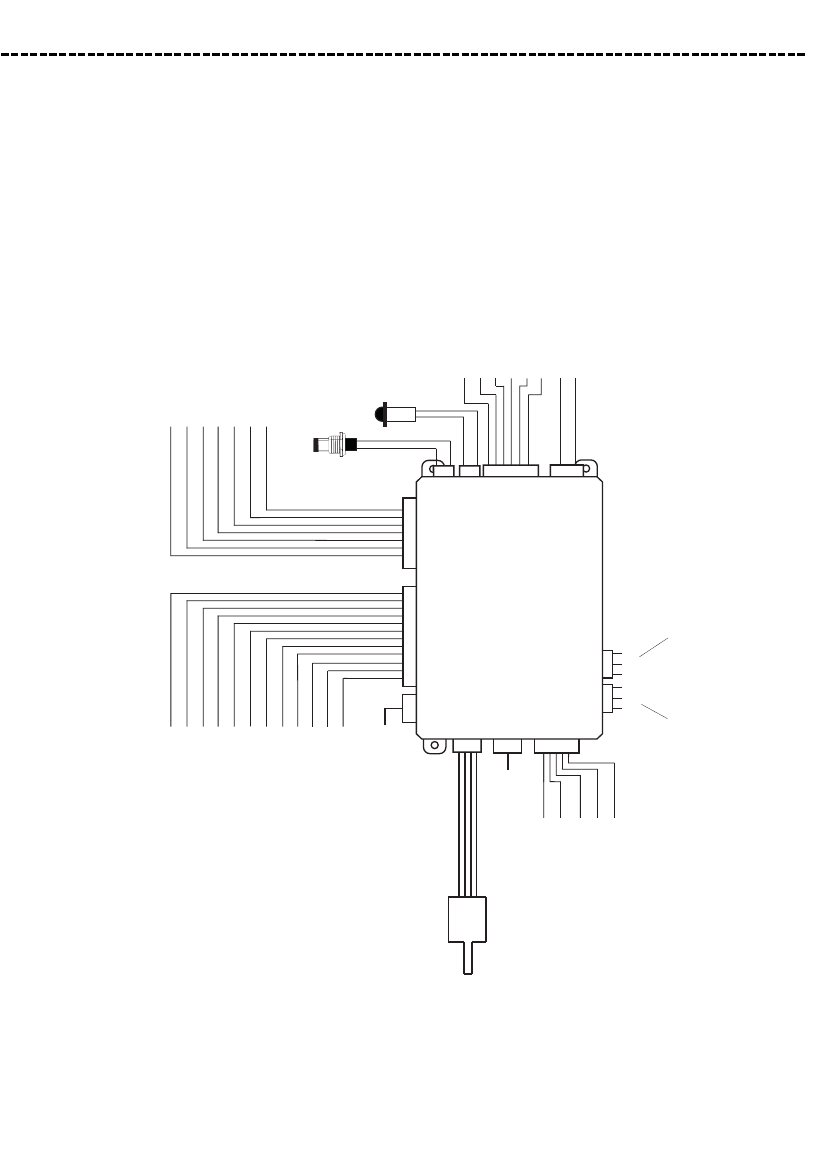
© 2004 Directed Electronics, Inc. Vista, CA 5533
wwiirriinngg qquuiicckk rreeffeerreennccee gguuiiddee
Jumper
tachometer
threshold
ORANGE ground when armed output
WHITE (+/-) parking light output
WHITE/BLUE (-) activation input
GREY (-) hoodpin shutdown input
BROWN (+) brake shutdown input
BLUE/WHITE (-) 200mA 2nd status/defogger
Transceiver
LIGHT-GREEN/BLACK (-) factory alarm disarm
GREY/BLACK (-) wait to start input
GREEN/WHITE (-) factory alarm rearm
VIOLET/BLACK (-) 200mA channel 4 output
GREEN (-) lock (+) unlock
BLUE (+) unlock (-) lock
Valet/Program
button
VIOLET/WHITE tachometer input
BLACK/WHITE neutral safety input
BitWriter
data port
563/564
Jumper
light flash
polarity
WHITE/BLACK (-) 200mA channel 5 output
LIGHT BLUE (-) 2nd unlock output
LED
Shock sensor port
BLACK/WHITE (-) 200mA domelight output
GREEN (-) door trigger input
BLUE (-) trunk trigger input
VIOLET (+) door trigger input
BLACK (-) ground input
Empty
BROWN (+) siren output
RED 12V constant input
RED/WHITE (-) 200mA channel 2 validity output BLUE 200mA (-) status output
ORANGE/BLACK 200mA anti-grind/ground when armed output
VIOLET (-) 200mA starter trigger
ORANGE (-) 200mA accessory trigger
PINK (-) 200mA ignition trigger
YELLOW (+) ignition input to remote start
PINK/WHITE 200mA programmable ignition/accessory trigger
+-LoHi
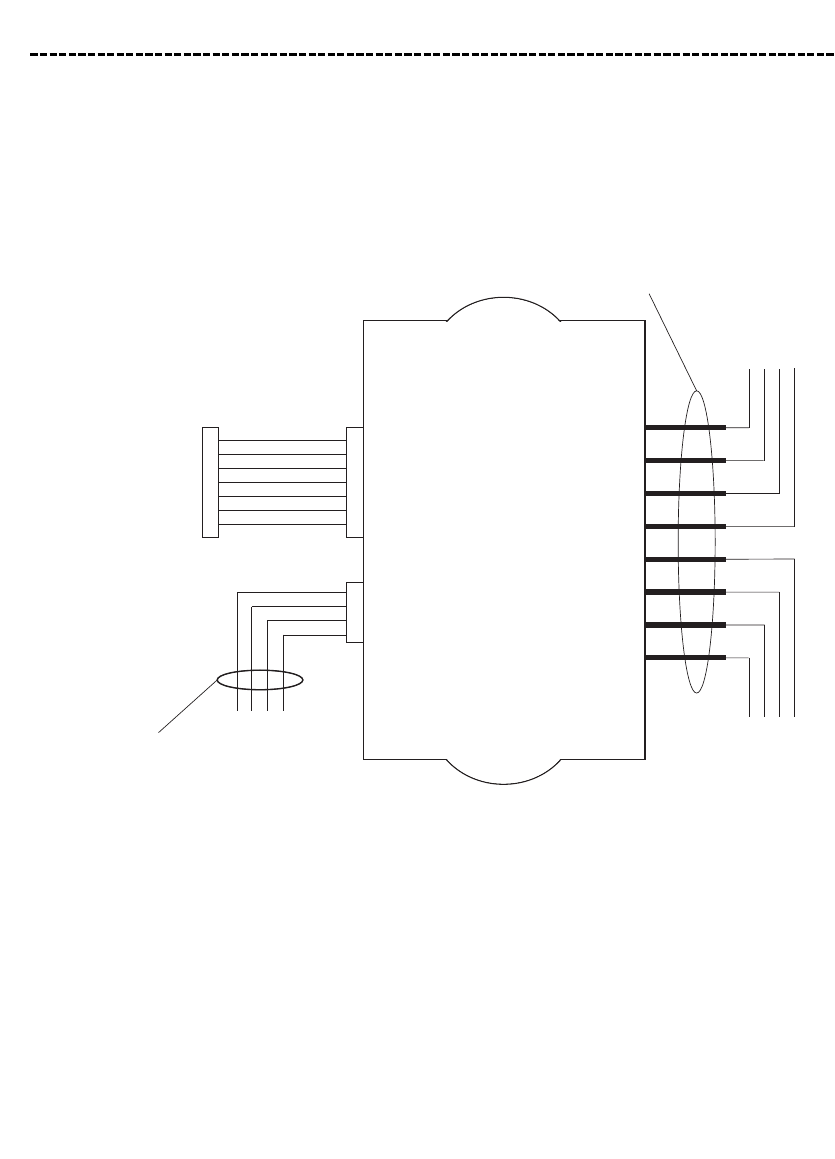
5544© 2004 Directed Electronics, Inc. Vista, CA
rreellaayy ssaatteelllliittee wwiirriinngg qquuiicckk rreeffeerreennccee gguuiiddee
PINK (-) 200mA 3rd ignition output
PURPLE (-) 200mA starter output
ORANGE (-) 200mA 2nd accessory output
BLUE (-) status output
Relay Satellite
ribbon harness
RED 12V constant input
PINK ignition output
RED/WHITE 12V constant input
PINK/WHITE 2nd ignition output
ORANGE accessory output
RED 12V constant input
GREEN key side starter wire
PURPLE starter side starter wire
These signals are from the
Relay Satellite ribbon harness
and are provided to drive additional
relays.
NOTE: If interfacing directly to a wire
in the car a diode must be used to prevent
the relay pack from activating.
Heavy Guage Wires

© 2004 Directed Electronics, Inc. Vista, CA 5555